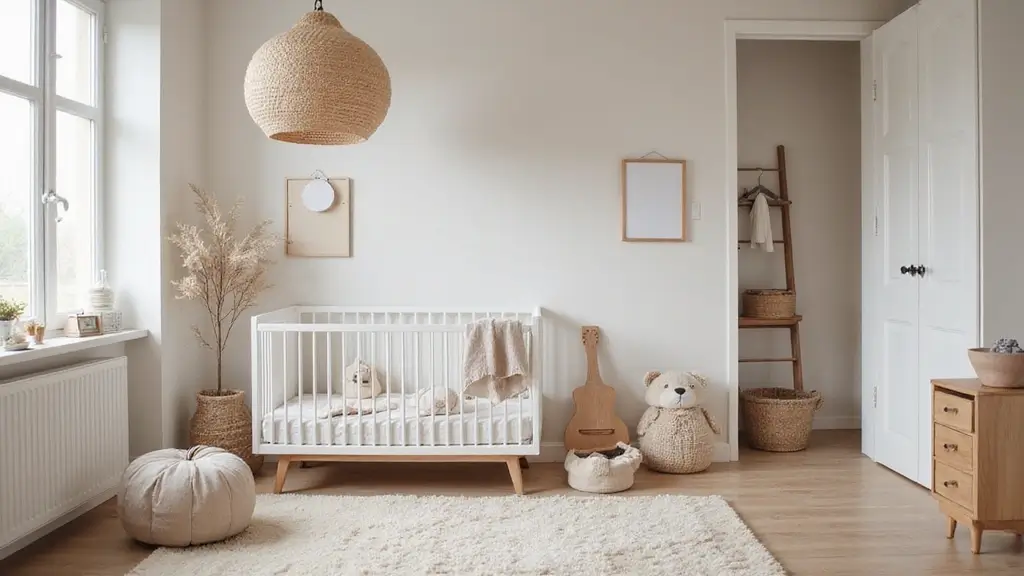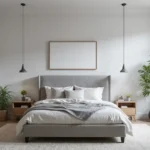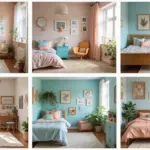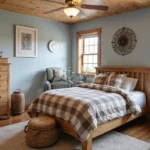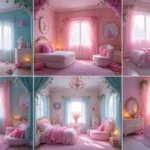I put this together because I want to help you design a baby boys bedroom that feels cute, calm, and cozy.
If you’re a parent, grandparent, or caregiver who wants a nursery that stays soothing and easy to live with, this post is for you.
Inside you’ll find 30 baby boys bedroom ideas that cover color palettes, textures, and layouts. They mix soft blues, warm neutrals, and gentle greens with simple patterns. They emphasize safe, practical choices like durable flooring, washable fabrics, and smart storage.
Think gentle lighting, soft bedding, and furniture that grows with your child. I include examples you can copy or adapt, from wall art to storage solutions. These ideas let you mix and match to fit your space.
These ideas help you create a space that feels peaceful at nap time and fun at playtime. You’ll know what to buy, what to DIY, and how to place things for easy daily routines.
Start with a simple palette and a calming focal point like a crib or rug. If you want, I’ll guide you through quick tweaks to adjust as your little one grows. Let’s tailor a plan that fits your home and your style.
1. Soft Scandinavian Color Palette
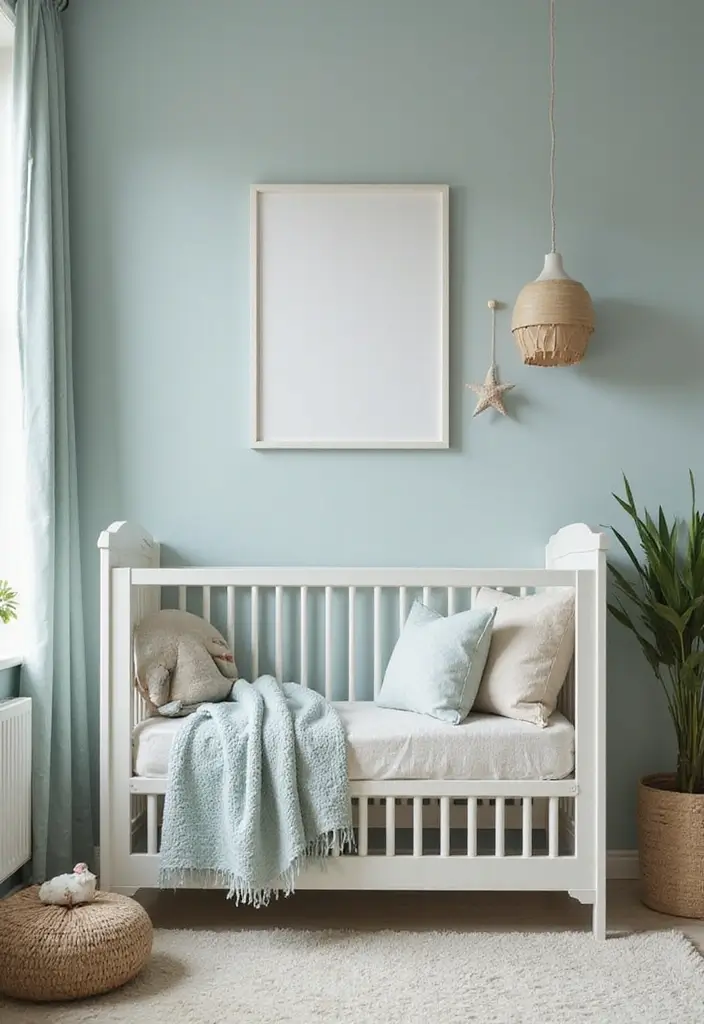
You want a nursery that feels peaceful and easy on the eyes. A soft Scandinavian color palette does the job. Think muted blues, pale greens, and gentle grays. These shades calm the mind and help your baby relax.
Build depth without noise. Use lighter walls as a quiet stage, then layer with textiles in slightly different tones. A touch of white keeps the room feeling open. Natural wood accents add warmth and a simple, honest look.
Here is how to apply this palette in practical ways:
– Wall color Choose wall paint in a light, calm hue.
– Bedding Pick bedding with soft patterns or solid colors that echo the wall.
– Textiles and art Add cushions, rugs, or wall art in coordinating shades.
– Furniture Use white furniture with natural wood legs or frames.
– Plants Bring in a small plant or two for a fresh touch.
– Lighting Keep the room bright with gentle indirect light.
This approach creates a serene space that looks cohesive and feels breathable. It also makes it easy to switch or refresh later as your baby grows. If you want a calm vibe, this is a reliable, stylish route that fits many room sizes and budgets.
2. Functional Furniture Solutions
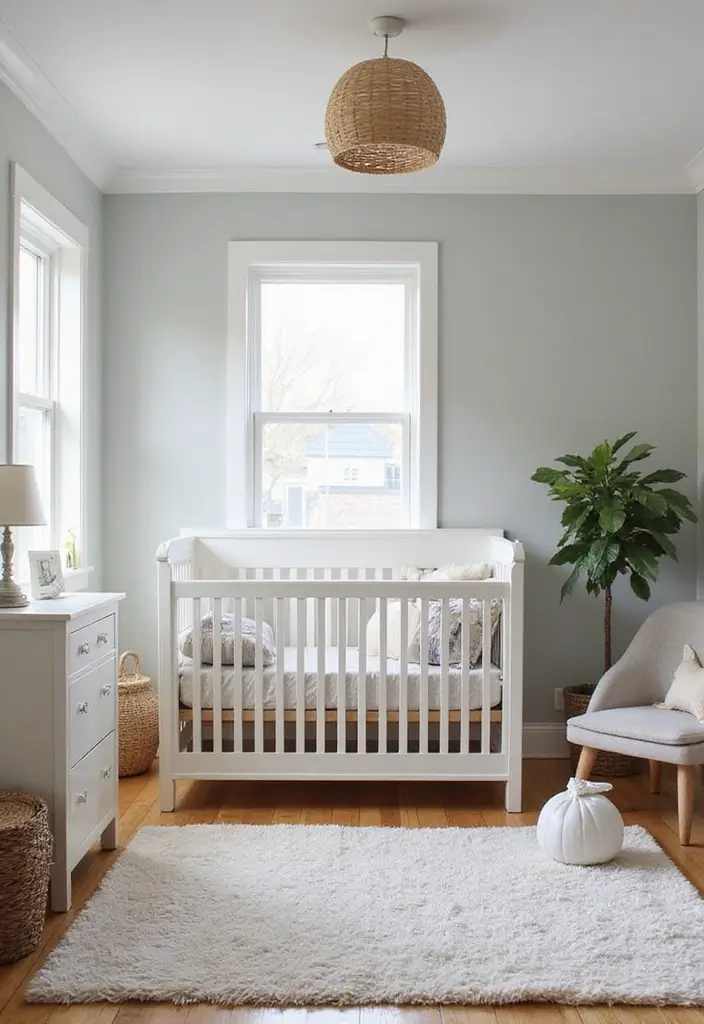
Your baby’s room should grow with them. You want furniture that lasts, stays safe, and keeps your days simple. Functional pieces save money and reduce clutter. Here is how to pick the right stuff that works now and later.
– Grow-with-you pieces
A convertible crib evolves into a toddler bed as your child grows. Look for sturdy conversion hardware and smooth, rounded edges. Check for safety locks and clear, simple instructions so you can do the switch without a headache.
– Smart storage that doubles as decor
Opt for a changing table with shelves below for diapers and toys. Add woven baskets and built-in cubbies to blend with color and texture. Pick finishes that wipe clean and stay sturdy with daily use.
– Safety in every detail
Pick furniture with soft lines and non-slip bases. Choose finishes that are low-VOC and easy to clean. Anchor heavy pieces to the wall and keep cords out of reach.
– Comfort for late nights
A small rocking chair or glider gives you a comfy seat for feeding and soothing. Look for a smooth glide and cushions that stay comfy after long nights.
– Calm, simple style
Choose gentle colors and simple shapes. Keep patterns small and the room uncluttered; this makes the space feel bigger and safer.
Next steps: measure your space, set a budget, and check safety features. With these choices you build a room that grows with your kid and stays calm. It stays tidy and easy to care for too.
3. Cozy Bedding Options
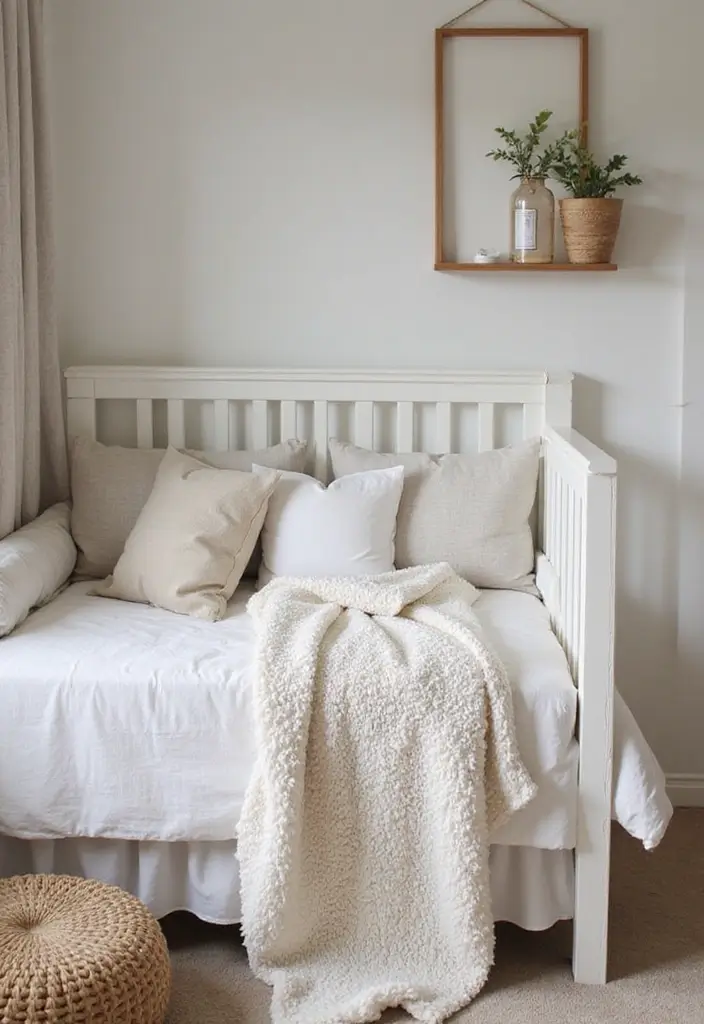
Your aim is a crib that feels warm without crowding it. You want sleep that comes easy.
Fabrics and safety
Choose fabrics that are soft and safe. Cotton or linen feel gentle on tiny skin. Pick breathable, hypoallergenic options. Neutral tones with simple patterns fit a calm, Scandinavian vibe.
Layering for comfort
Layering adds depth without crowding the crib. A plush blanket or soft quilt can add warmth when you hold the baby, then tuck it away. Skip loose blankets in the crib. If you need extra warmth, use a wearable blanket or sleep sack.
How to shop and stack bedding
– Use fitted sheets that are easy to wash and change.
– Pick a lightweight blanket worn as a sleep layer or a sleep sack for warmth without overheating.
– Look for sets that include matching accessories to keep the look coordinated.
– Consider a crib skirt to hide storage and finish the look.
Safety note
Avoid decorative pillows, stuffed toys, and any loose blankets in the crib. This keeps sleep safe and peaceful.
Investing in cozy, well‑chosen bedding helps your baby nap better and sleep more calmly. You and your little one will feel the difference.
4. Nature-Inspired Decor
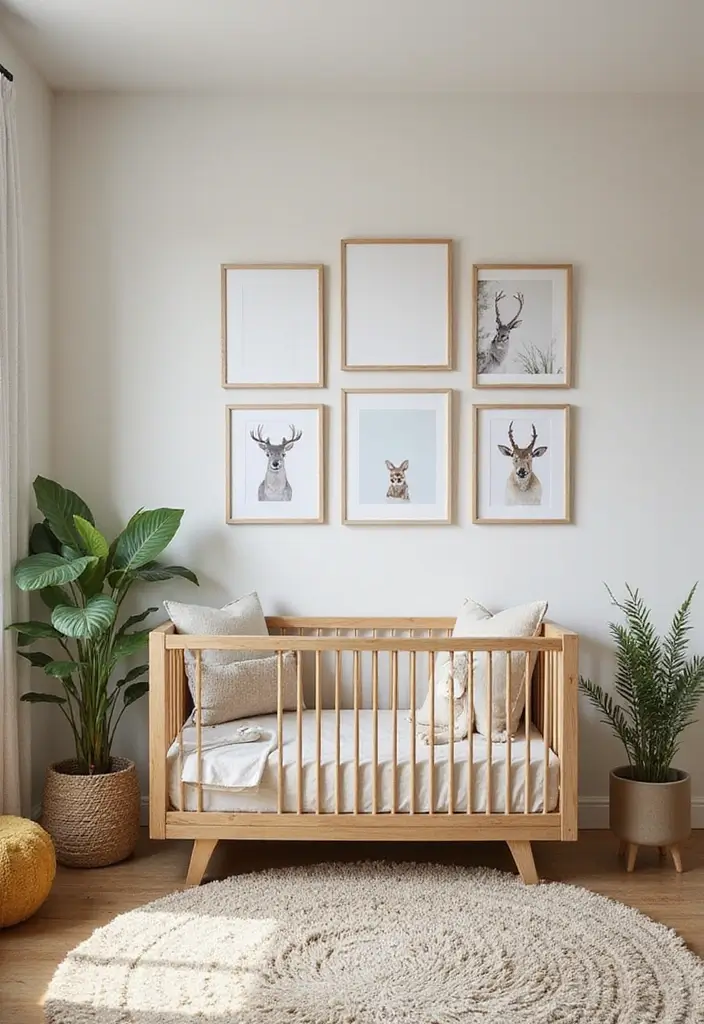
You want a baby boy’s room that feels calm, warm. Nature décor helps. It adds texture and color that soothe.
Practical ways to bring nature into the room
Here is why it works. Natural elements connect the room to the outdoors, and that quiet link helps kids settle.
Let’s break it down with practical steps you can take today:
– Choose wooden furniture that’s simple and sturdy. This keeps the space clean and safe.
– Add plants or small succulents on shelves or by the window. They brighten the room without clutter.
– Put up wall decals that show trees, mountains, or animals. They spark gentle imagination.
– Choose rugs and curtains from natural fibers like cotton or jute. They feel soft and grounded.
– Include wooden toys or decor items that are both useful and pretty. A rattle on a shelf blends in.
– Create a nature gallery wall with soft nature prints. Frames in warm wood tone tie the look together.
Finish with a safe, washable paint in off-white, taupe, or moss green on the walls. These tiny touches bring the outdoors inside and help your baby feel secure and snug.
5. Minimalist Storage Solutions
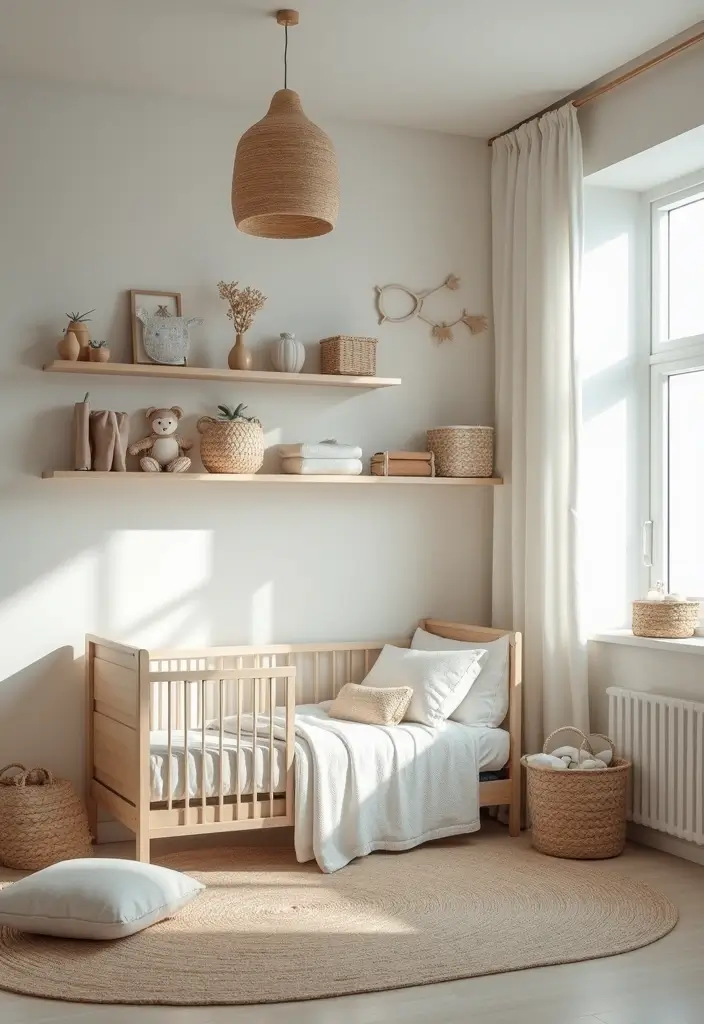
Your baby’s room should feel calm. When toys and clothes pile up, peace hides. Minimalist storage helps you keep order without a crowded look. Choose bins and baskets made from natural materials like wicker or cotton. They add texture and stay strong as your child grows. Texture from natural fibers makes the room feel warm.
– Open shelves Place low, open shelves where toys and books sit within sight. Your child can grab favorites and put them back, keeping the floor clear.
– Label baskets Use simple labels or pictures on baskets. This helps you find items fast and teaches your child where to return them.
– Multipurpose furniture Look for pieces that hide things away. A storage ottoman or a crib with drawers turns tiny rooms into calm spaces.
– Wall storage Mount slim shelves for books and toys. It keeps floors free and adds clean lines to the room.
With these ideas, your baby’s space stays neat, peaceful, and easy to care for. Start small. Pick one area, like a shelf, and test the look for a week. Keep a simple color palette and repeat materials to keep the calm vibe. That way you save time and make tidy a natural habit. Your space will stay quiet and comfy.
6. Playful Wall Art
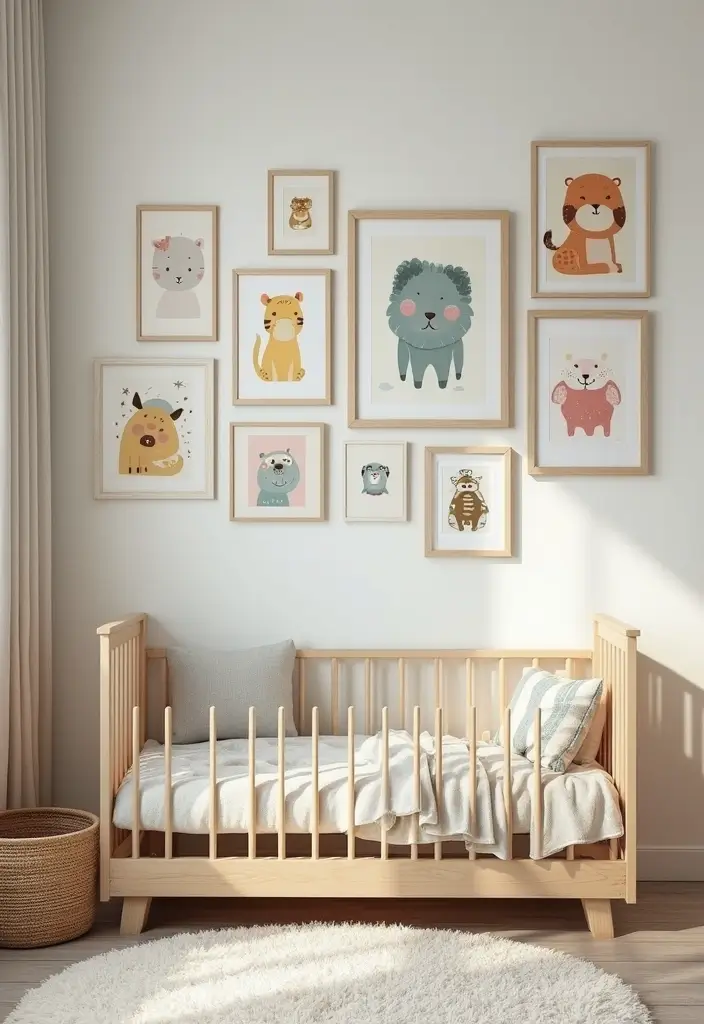
If you want a baby boy’s room that feels calm, cozy, and cute, wall art is your ally. It adds personality without crowding the space. You get soft color, clean lines, and a touch of whimsy all in one move. Pick designs that fit a Scandinavian vibe: simple line drawings, gentle animals, or abstract shapes in muted tones. Hang art at your child’s eye level so their curiosity is sparked as they grow.
Gallery wall ideas
– Create a mixed wall with framed art, photos, and small fabric hangings. Use white or light wood frames to keep the look airy.
– Try a tidy grid or an organic layout. Symmetry feels calm; a casual cluster feels playful.
Removable decals
– Use peel-and-stick decals with friendly characters or nature scenes. They’re easy to change as your child grows.
– Choose decals with soft edges and muted colors so they blend with the room, not overpower it.
Growing with him
– Pick pieces that your child can enjoy for years, not ones that shout “nursery.” Think animals, stars, or trucks in gentle shades.
– Avoid tiny, busy patterns that may fade into the background as eyes get sharper.
Personal touches
– Include a few family photos or art from older siblings. It makes the space feel personal and loving.
– Rotate one or two pieces seasonally to keep the room fresh without a full redo.
Next steps: measure wall space, pick 3-5 core pieces, and test layouts with paper cutouts before mounting.
7. Cozy Reading Nook
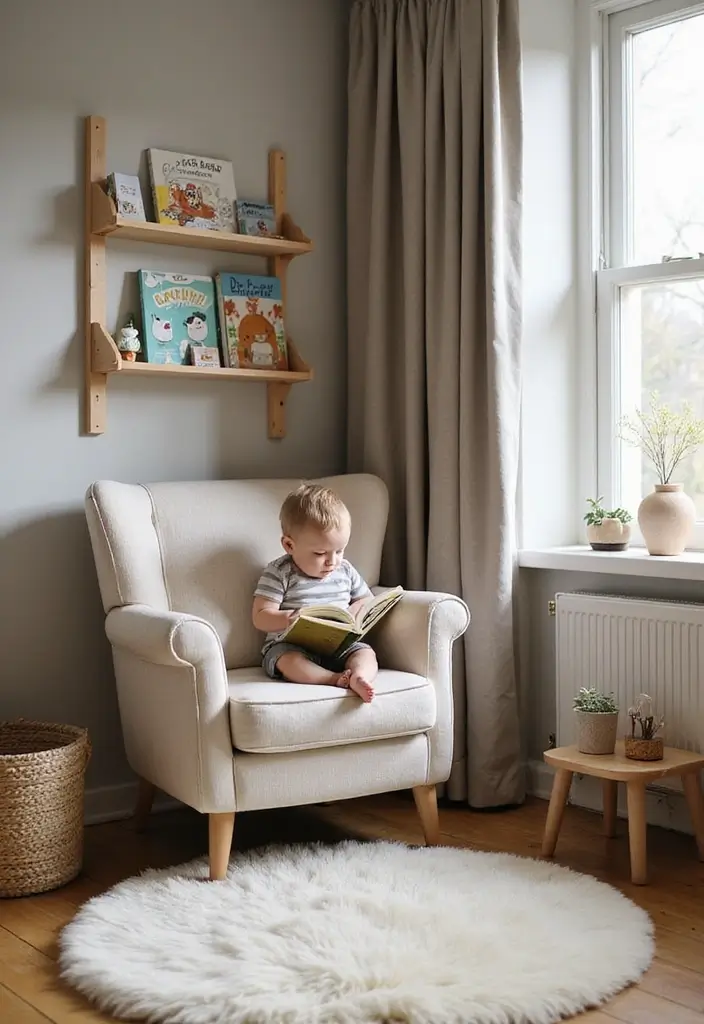
You want a cozy reading nook in a baby boys room where reading feels inviting. It should be calm, easy to reach, and simple to keep tidy. Keep the look simple so it stays neat as toys come and go. This plan gives you a soft, memorable spot for stories every day.
– Seat and comfort Pick a small chair, a bean bag, or a thick floor cushion that wipes clean and stays comfy.
– Books within reach Add a low bookshelf filled with colorful picture books and short reads, and rotate titles weekly so there is always something new.
– Warm ground Lay down a plush rug that cushions knees and makes the space feel warmer.
– Soft lighting Use a gentle lamp or string lights to cast a warm glow, not glare.
– Personal touch Add a few kid-friendly art pieces or simple quotes that match your child’s interests.
– Practical extras Keep a small basket for blankets and a quick-clean book bin to make tidy up easy.
This nook grows with your child and builds a love for stories. With soft colors and calm textures, you give them a quiet place to dream, learn, and imagine.
Safety and setup tips you can use now: Choose fabrics that wipe clean and stay soft. Choose a shelf that is sturdy and anchored. Keep cords and small parts out of reach.
8. Themed Decor Elements
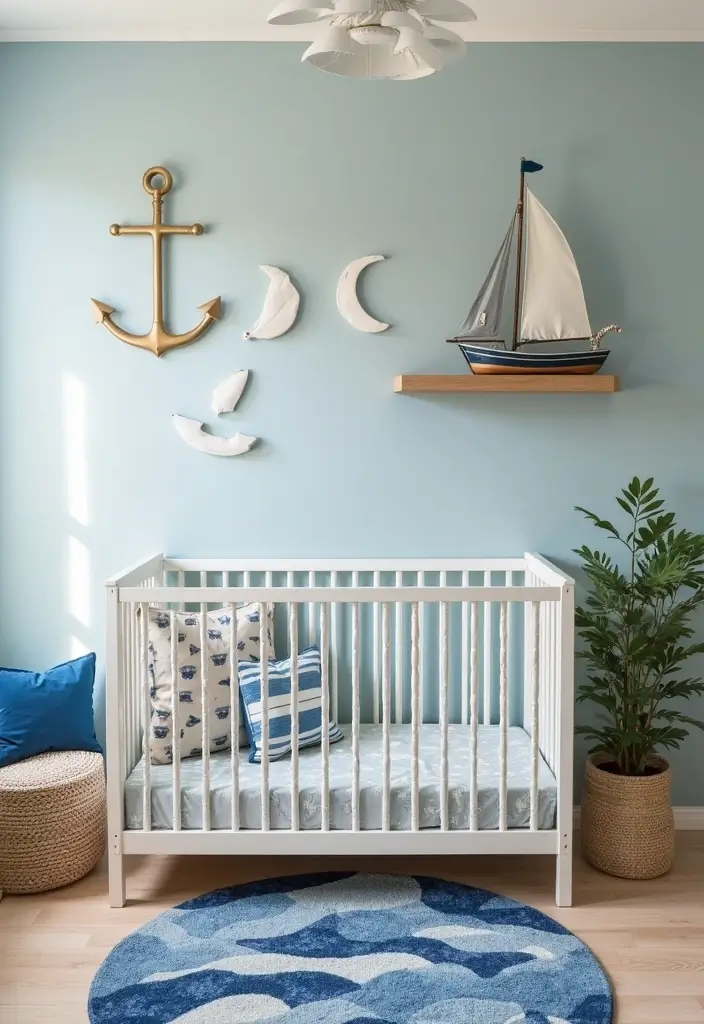
You want a baby boy room that feels calm and friendly. Themed decor helps you pull the space into one idea you can live with.
Here is why themed decor helps you keep the room simple and friendly.
– Theme choice: Pick a theme you love, like nautical, jungle, space, or cars. This gives you a clear color plan.
– Anchor piece: Choose one bold item to set the mood. A rug, bedding, or wall mural becomes the room’s north star.
– Wall art: Find prints or decals that match the theme. Keep colors in the same family so everything fits.
– Echo details: Add small touches that reinforce the idea. Cushions, toys, night lights, and shelves should all nod to the theme without crowding.
– Balanced furniture: Use neutral pieces so bright decor reads as accents, not noise. Light wood, white, or gray furniture helps calm the look.
Next steps: keep the palette tight. Limit yourself to two or three main colors. Mix soft textures like cotton, felt, and wood to add depth. Add warm lighting to soften the room.
Examples to spark ideas: Ocean with a blue rug and boat decals; Jungle with leaf prints and gentle animal toys.
Also, check size, storage, and path space to keep the room easy to move in and clutter-free.
9. Soft Lighting Options
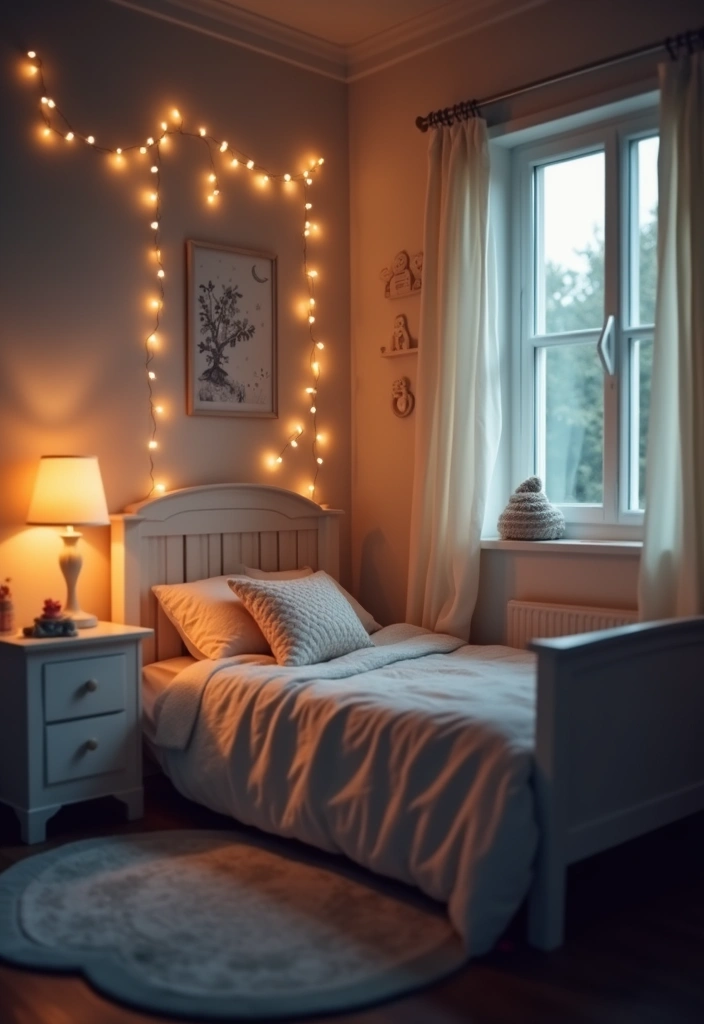
Soft Lighting Options
Soft lighting can set the mood in your baby boy’s nursery. It helps you see during night feeds and keeps the room calm for naps. You want light that is warm, adjustable, and easy on tiny eyes.
Here is why lighting matters. It guides bedtime, supports sleep, and makes late feeds gentler for you both.
– Hang fairy lights or soft LED strips along the walls or around the crib.
– Place a soft-glow nightlight within reach for nighttime comfort.
– Use dimmers or fixtures that let you lower brightness for late feeds or soothing play.
– Layer lighting with an overhead ceiling light and a lamp to add versatility.
– Pick shades that diffuse light gently, stopping glare from hurting little eyes.
– Keep bright bulbs away from the crib and away from your baby’s line of sight.
Soft lighting gives your room a calm feel and helps your baby settle faster. With this setup you can switch easily from gentle play to quiet bedtime. Start small with one setup, then add a second layer later as you grow into the routine.
If you share the room, keep the main light dimmed and ready for quick feeds. Keep a portable lamp within reach to move light.
10. Textured Accents
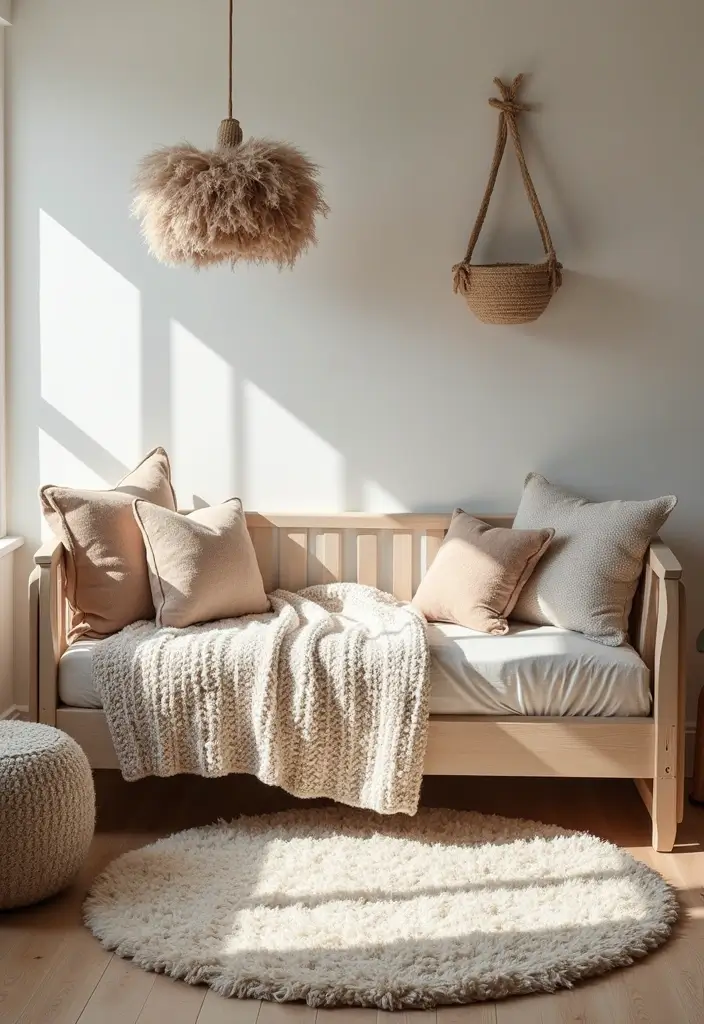
Your baby boy’s room should feel warm, calm, and inviting. Textured accents add warmth and depth. They invite touch and soften the room. Here is why texture matters: it cushions the eye and makes the space feel cozy.
Texture ideas you can use now
– Use a chunky knit blanket on the crib or chair for extra warmth and softness.
– Layer rugs of different sizes and textures on the floor to create a comfy path and a warm feel.
– Add pillows with varied fabrics, such as velvet or corduroy, to bring contrast and tactile interest.
– Choose curtain fabrics that soften the light and add a tactile element to the windows.
Textured accents work with any color and style. They stay comfy as your little one grows. Keep the palette simple so textures shine. Mix small and big textures to avoid a busy look. Clean fabrics like cotton, wool, and linen stay durable for daily use.
Next steps: pick two or three textured pieces to start, then add one new piece every few months. Your room will feel richer and more welcoming without losing calmness.
If you need quick wins, swap in a soft curtain and a cozy pillow set this week.
11. Open Concept Layout
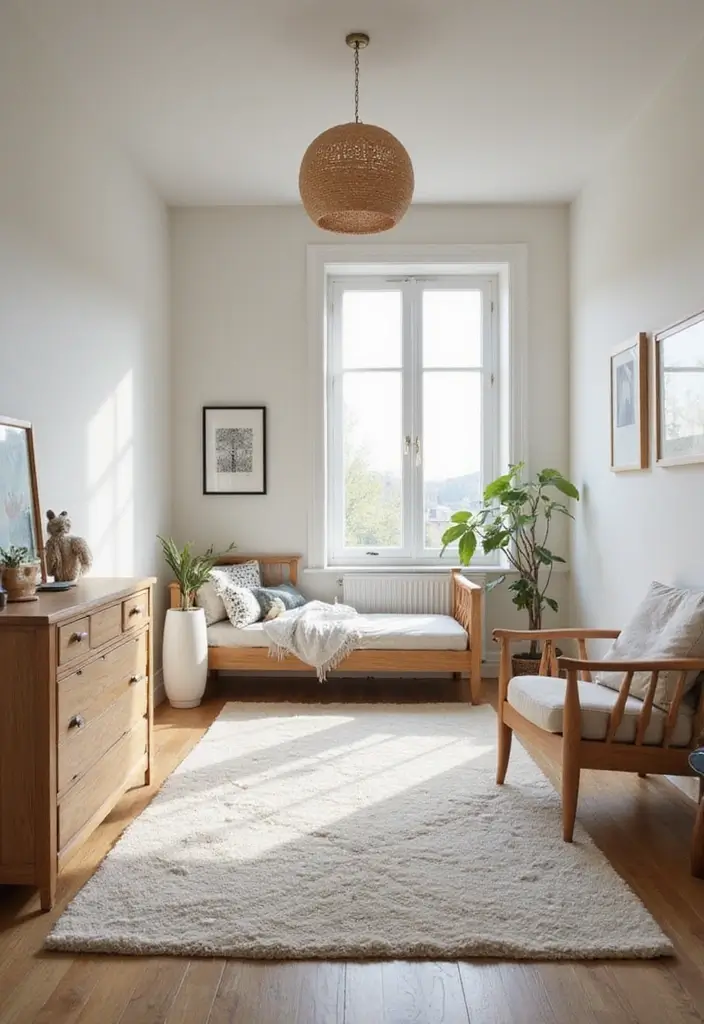
Here is why an open concept layout helps a baby boy’s bedroom. It keeps the space airy and easy to move in. It makes play safer and daily care quicker for you. It gives you one clear view of the room at a glance.
Try dividing the room into zones: sleep, play, and changing. This helps you stay organized and on top of daily routines.
– Keep the crib a little from the wall so you can reach from all sides.
– Choose lightweight furniture you can move easily when you need to shuffle things around.
– Leave clear pathways so you and your child can move safely and avoid trips.
– Pick pieces that grow with your child, like a dresser that becomes a changing station or a low shelf that later holds toys.
This setup feels modern and calm. It shows off clean lines and simple storage, not clutter. It also makes routines smoother, from diaper changes to bedtime. Keep the floor mostly clear, use storage bins at child height, and pick soft, neutral colors for a serene mood. Start small: plan a simple path, pick flexible furniture, and keep essentials within easy reach. Next steps? Map your space on paper, measure doors, and test how furniture flows before you buy.
Adjust as your family grows.
12. Personalized Touches
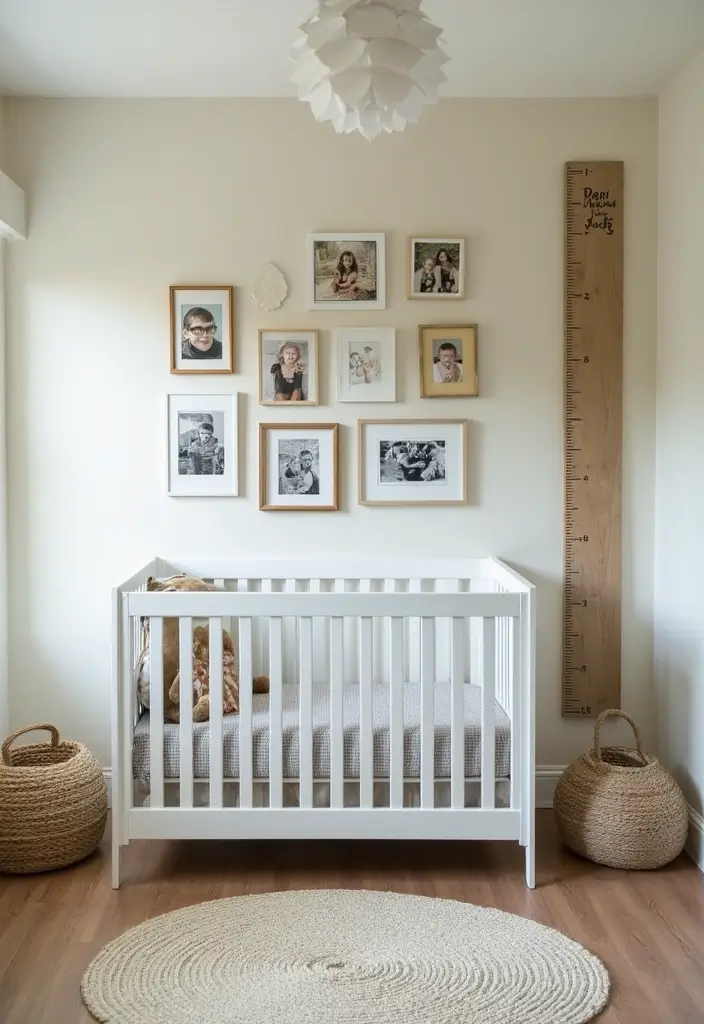
You want a baby’s room that feels warm and truly theirs. Personal touches make that happen. They show your family’s story and add calm, cozy vibes. Let’s make this easy and safe.
– Custom wall art or a name banner
Pick soft colors and simple shapes. Create a small wall piece with your baby’s name or initials. Use wood, fabric, or canvas that’s easy to wipe clean. Place it where it’s first seen when you walk in.
– Family photos in simple frames
Choose a few favorite shots and frame them in matching colors. Arrange them in a tidy grid or a curved line. It turns the wall into a gentle memory wall you and your child can admire daily.
– A keepsake quilt or blanket
Order or sew a quilt with the name or initials. Or add a sewn label with a date. Your baby will feel hugged by this personal touch.
– A growth chart that doubles as art
Use a wooden ruler or fabric chart painted in soft tones. Make it part of the decor rather than a distraction. Secure it high enough to stay out of reach, easy to clean, and fun to watch as they grow.
– Short, meaningful quotes
Paint or stitch tiny quotes like “You are loved” in a calm font. Keep the lines brief and in colors that echo the room. It adds a hopeful message without shouting.
– A small memory board
Set a corkboard or fabric pin board on a dresser or wall shelf. Pin milestones, tiny outfits, or tickets from family outings. Swap items in as you collect new memories.
By mixing these ideas, you build a room that feels personal, inviting, and easy to update as your child grows. It stays calm, cute, and cozy.
13. Incorporating Cultural Elements
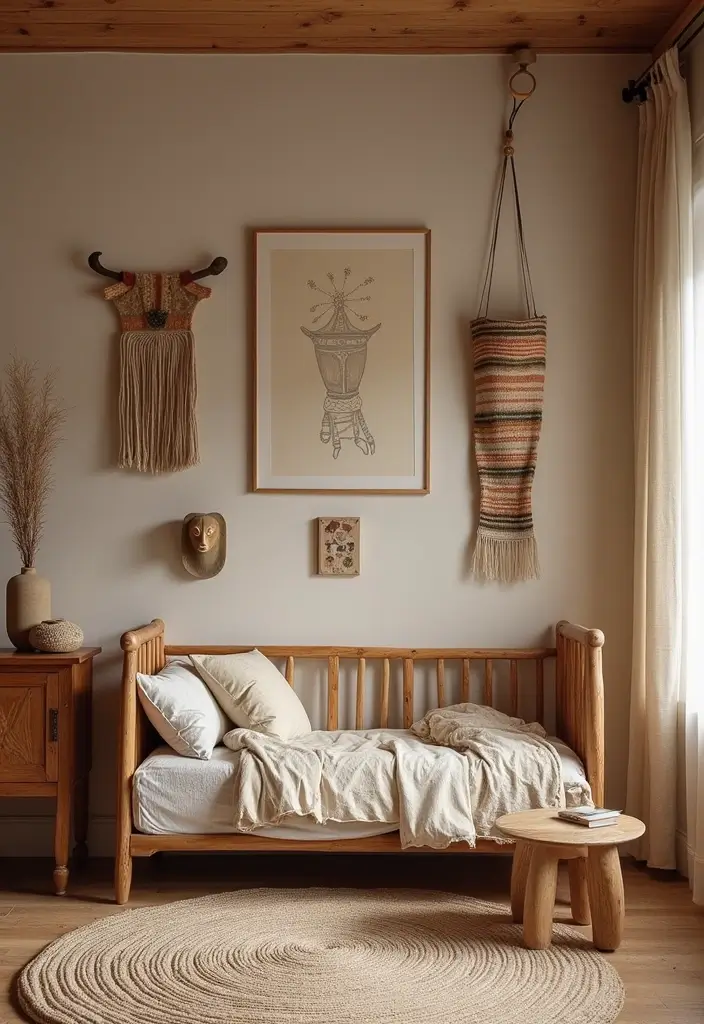
You want a baby boy’s room that feels warm and real. Cultural elements help your child see where your family comes from and why it matters. Here are practical, kid-friendly steps you can use today to weave heritage into decor.
– Use traditional textiles as decor, like a woven blanket on a chair or a bright rug on the floor.
– Display art that reflects your heritage with framed prints or folk pieces that spark questions.
– Include items that show family traditions in play, such as a story pillow or a drum.
– Choose furniture that shows craft, like hand-carved pieces or natural wood.
– Work with local makers by buying handmade items from nearby artisans.
– Use colors and textures that echo your culture, mixing warm tones with bright accents.
– Create a small cultural display shelf with a few meaningful items you rotate.
– Rotate pieces with the seasons to keep the room fresh and inviting.
– Document the stories behind items and share them with your child as you decorate.
– Keep safety in mind by securing wall art and avoiding tiny parts near sleep spaces.
Cultural elements add character and give your baby’s room a unique touch that honors your family’s history.
14. Soft Flooring Options
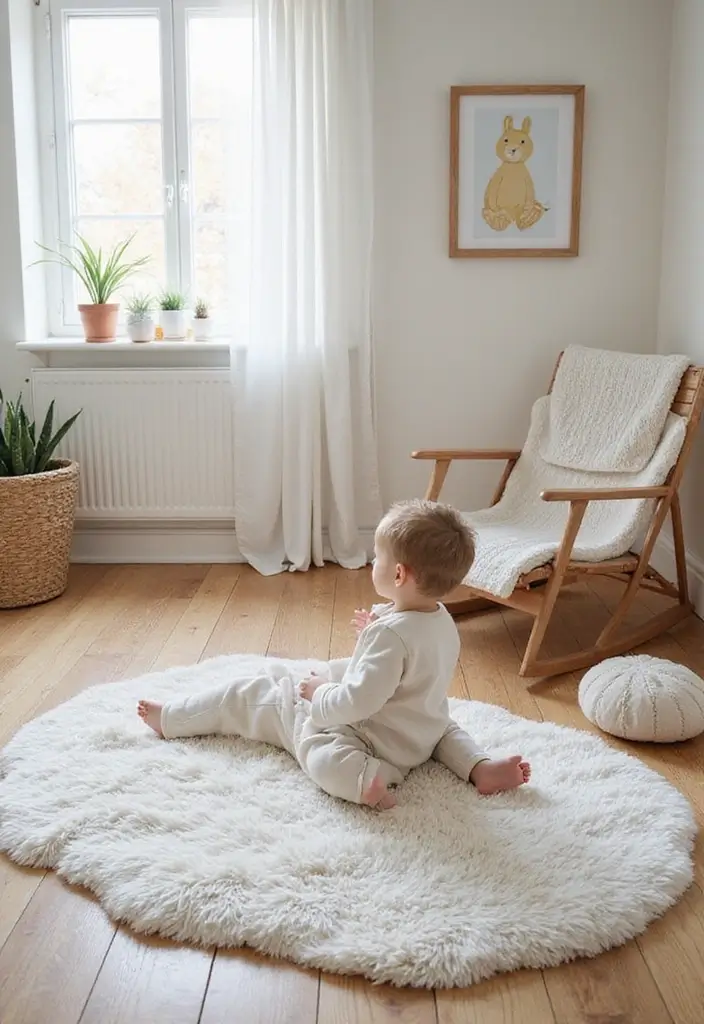
You want a floor that keeps your baby comfy and safe as they explore. Soft flooring makes a big difference. It cushions tumbles and feels warm under tiny feet. It also helps keep the room calm and quiet.
Here is why these options work, plus how to pick and use them:
– Area rugs that define play zones. Choose low-pile, washable rugs. Add a non-slip pad under them to stop slips. Pick colors that hide crumbs and are easy to wipe clean.
– Wall-to-wall carpet. A plush carpet gives a soft, seamless surface for rolling toys and crawling. Vacuum regularly and spot-clean stains quickly. Look for kid-friendly backing and good stain resistance.
– Foam interlocking tiles. These tiles make a safe, bouncey play mat. They’re easy to install in a corner and swap as your child grows. Wipe them down after messy moments.
– Washable fabrics and fibers. Seek rugs and mats that go in the washing machine or are simple to wipe. Avoid pieces that shed fibers or trap crumbs.
Next steps: measure the room first. Pick one main soft option, then add a couple of washable rugs for zones. Use a non-slip pad and keep edges flat. Clean regularly. This choice boosts comfort and safety for every crawl and tumble.
Soft flooring isn’t just about comfort; it’s the secret to a calm and safe baby boys bedroom. Choose cozy rugs or carpet to cushion their tiny steps and make exploring a joy!
15. Eco-Friendly Decor Choices
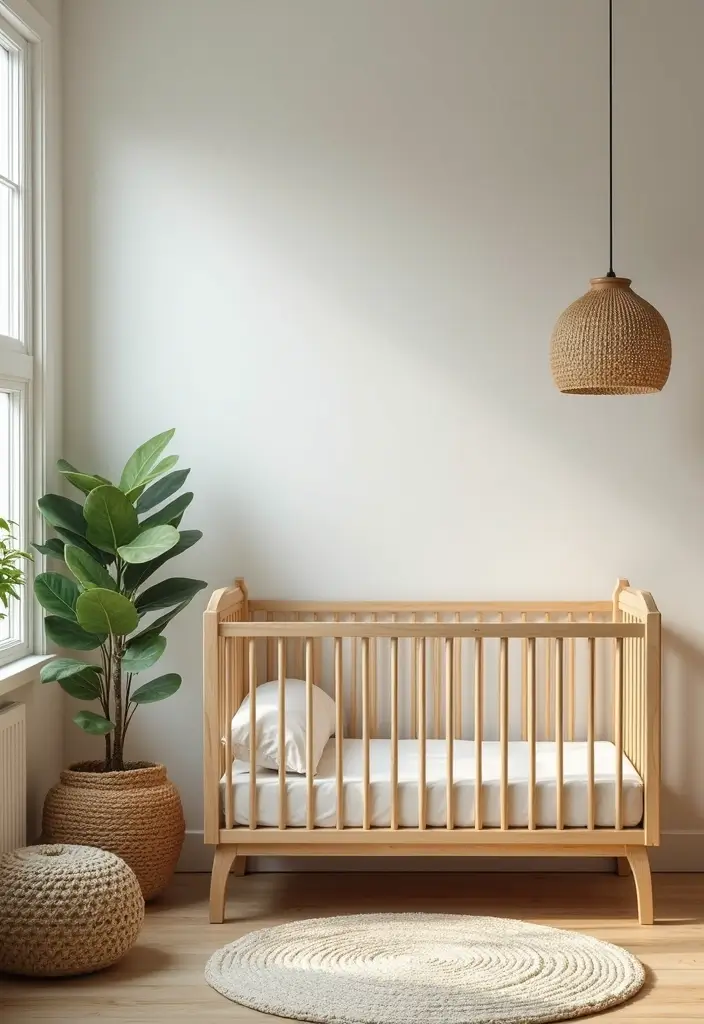
You want a safe, eco friendly nursery that feels calm. Eco choices help your baby and the planet. Here is why it matters.
– Natural paints and finishes
Choose paints with low or zero VOCs.
This helps keep fumes down and the air safer for your child.
– Sustainable furniture
Pick bamboo or reclaimed wood.
Look for FSC or other green certifications to ensure the wood is sourced responsibly.
– Organic textiles
Use bedding and blankets made from organic cotton.
If you can, seek GOTS certification for fabrics.
– Non toxic surfaces
Use water based, non toxic finishes on furniture.
This reduces exposure to harsh chemicals near the crib.
– Natural or recycled decor
Choose rugs from natural fibers like jute or cotton, or from recycled fabrics.
They feel soft and still honor the earth.
– Organic toys and accents
Choose toys and decor made from wood, cotton, wool, or other organic materials.
This keeps plastic out of your child’s space and lowers chemical exposure.
– Upcycle and reuse
Repurpose jars, baskets, and wooden crates as storage.
It saves money and trims waste.
– Smart shopping tips
Ask about materials and finishes before you buy.
Read labels and look for trusted certifications.
– Start small and grow
Begin with a few eco pieces you love.
Add more over time as you find good deals.
– Next steps
Start with one eco piece you really like.
Then expand your collection as you go.
16. Interactive Play Areas
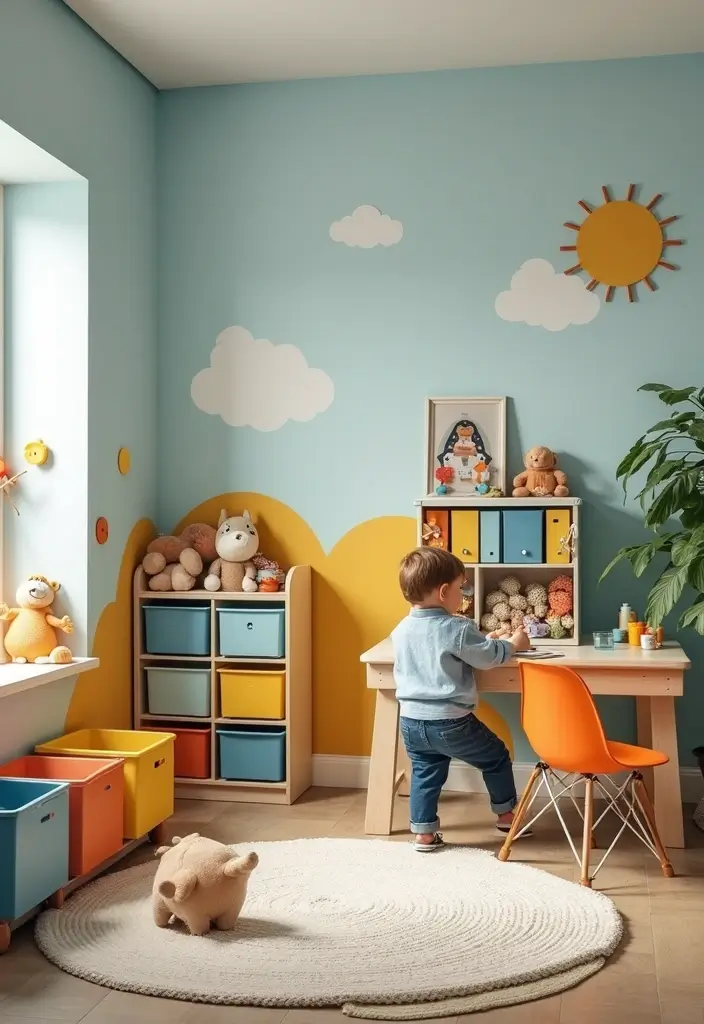
You want a baby boy’s room that invites play and stays easy to tidy. An interactive play area can do that. It sparks curiosity. It builds early skills. It keeps toys in one friendly zone.
How to set up your interactive play zone
– Pick a corner of the room that has good light and is easy to watch over.
– Lay down a soft play mat so little knees land on a comfy, safe surface.
– Add a sensory bin with simple, safe items like fabric scraps, smooth blocks, and small cups.
– Include a small climbing ladder or a soft, low structure for safe climbing.
– Place colorful storage bins on a low shelf to keep toys organized and reachable.
– Set up a small craft table for drawing, sticker play, or building blocks.
– Leave space for interactive wall toys that grab attention and invite touch.
– Create a sensory corner with mixed textures, colors, and gentle sounds.
– Choose washable materials and easy-clean surfaces so messes are quick to tackle.
Here is why this setup helps: kids move more, explore with fingers and eyes, and learn through play.
Next steps for lasting appeal: rotate toys, keep bins labeled, and refresh textures seasonally.
17. Monochromatic Scheme
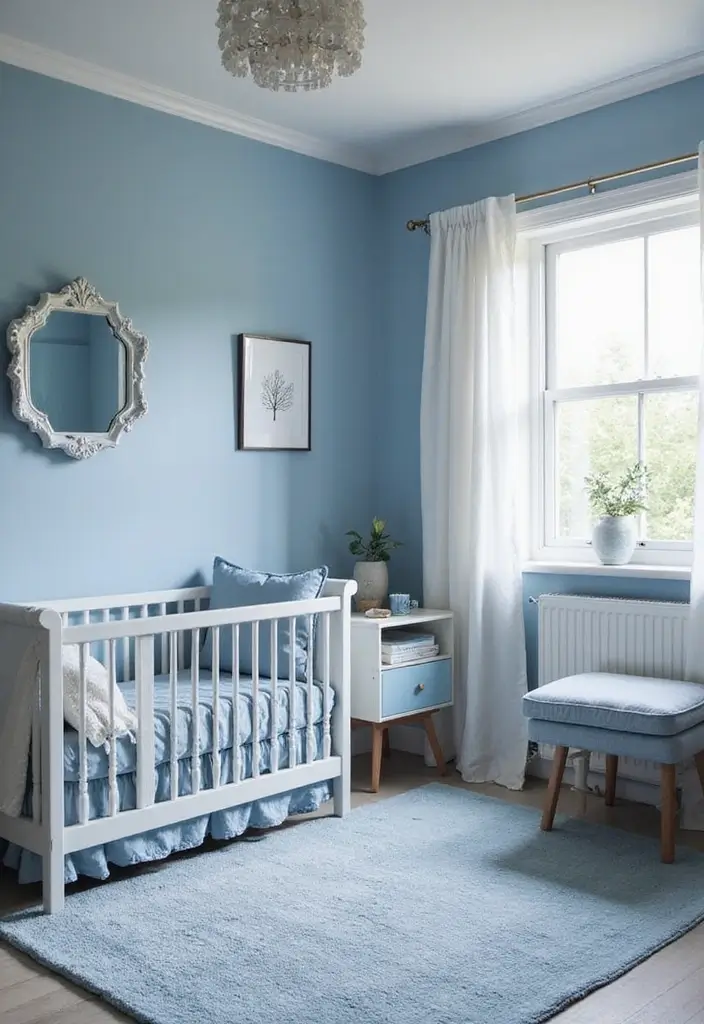
Here is why a monochromatic scheme works in a baby boy room. It feels calm and clean. It stays modern without loud color clashes.
– Base color Start with one base blue family color. Pick powder blue, steel gray, or navy as your anchor for walls, furniture, and big textiles.
– Patterns and textures Mix patterns and textures in the same color family. A blue striped sheet, a solid blue quilt, and a knit pillow add depth without breaking the color rule.
– Shading and depth Vary shades across pieces. A lighter blue dresser, a mid-tone chair, and a dark blue rug create layers that look rich and cohesive.
– Contrast Add contrast with white or natural wood. White trim or wood legs keep the space from feeling flat and help the color pop.
– Palette limits Keep the palette simple. Limit to 3-4 blues and a couple of white or wood accents to tie it together.
Here is how to implement it. Paint walls in the lightest shade. Choose textiles in two or three related hues. Pick furniture in varied tones of the same family. Finish with decor in white or wood.
Next steps: test paint swatches in daylight and in lamp light. Move pillows and blankets to refresh the room as your baby grows.
18. Vintage-Inspired Decor
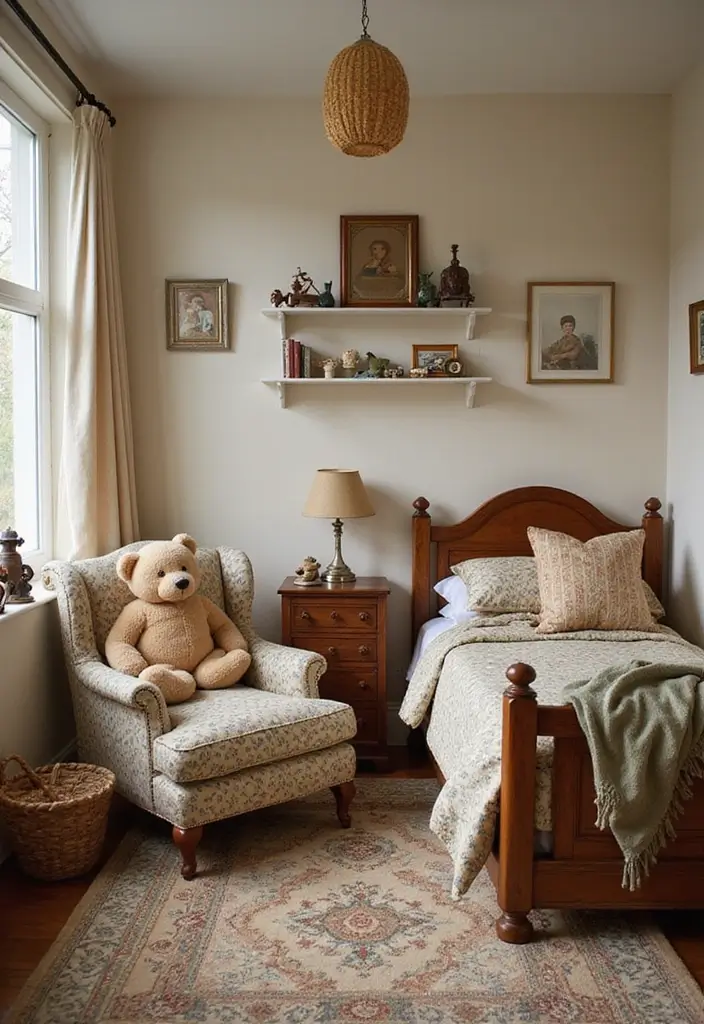
Vintage-Inspired Decor
You want a room that feels soft, calm, and full of memories. Vintage-inspired decor can give you that mood. It adds charm without making the space feel busy. Here is why it works: it blends texture, color, and simple stories into one room.
Anchor pieces
– Pick a few items that carry history. A vintage rocking chair can become a cozy nursing nook. Place it by a window, add a soft throw, and it becomes a calm spot to soothe baby.
– Add a dresser or crib with a gentle patina. Let the wood show age through finish and grain, which adds character without shouting.
– Choose vintage-patterned textiles for bedding or curtains. Look for soft florals, dots, or subtle stripes that fit your theme.
Textiles and wall art
– Decorate with antique wall art or family heirlooms. Frame memories and let them become a small gallery.
– Place retro toys on shelves as decorative pieces—just enough to spark imagination.
– Create a tiny wall display or tray with keepsakes. It tells stories without clutter.
Mix and care
– Balance old and new. A modern rug or lamp helps the room feel current.
– Keep items easy to clean and safe. Check edges and finishes for sharp spots.
– Rotate a few pieces over time to keep the room fresh.
The payoff
A warm, inviting space that invites stories and sparks imagination.
Start small. Buy one heirloom you love, then build around it.
19. Animal Motifs
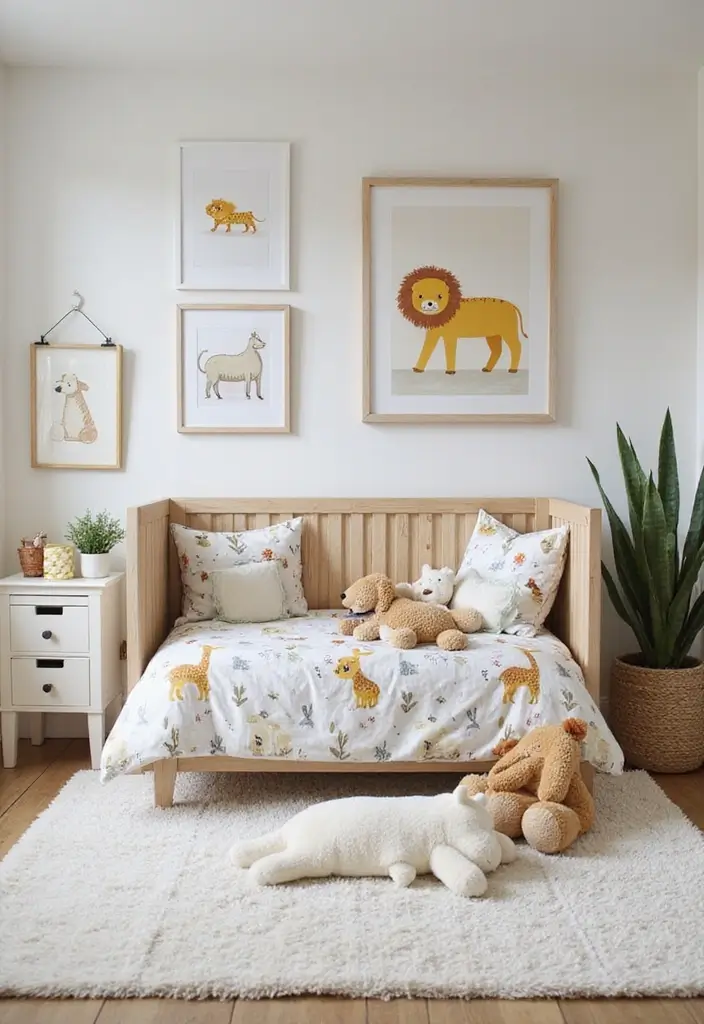
You’re aiming for a baby boy room that feels playful but calm. Animal motifs can help you hit that balance. They add charm without clamor. Here is how to use them in a real room.
– Bedding with friendly animal prints
Choose sheets or a duvet that shows cute animals. Pick colors that match the room. Prefer soft, washable fabrics. A single set can refresh the look in minutes.
– Wall art that fits the space
Hang small framed animal pictures. Keep frames in matching colors. Place a large piece above the crib and smaller ones nearby.
– Plush toys that double as decor
Add plush animals on shelves or by the crib. They add a soft touch and invite storytime.
– Animal-shaped pillows and rugs
Pillows in animal shapes, like fox or bear. A paw-print rug adds texture. These pieces pull the theme together.
– Keep the palette calm
Limit prints to 2-3 animals. Let these colors guide bedding and decor.
– Safe, kid-friendly choices
Choose non-toxic fabrics and easy care. Check washing guidance. Avoid loose small parts.
– Growth-ready tips
Pick friendlier animals that stay as your child grows. Avoid scary or busy art.
With these ideas, you get a room that invites touch and imagination. You can swap a print or pillow as your child grows. Keep the look simple and confident, and your space stays cozy and ready for play.
20. Customizable Decor Items
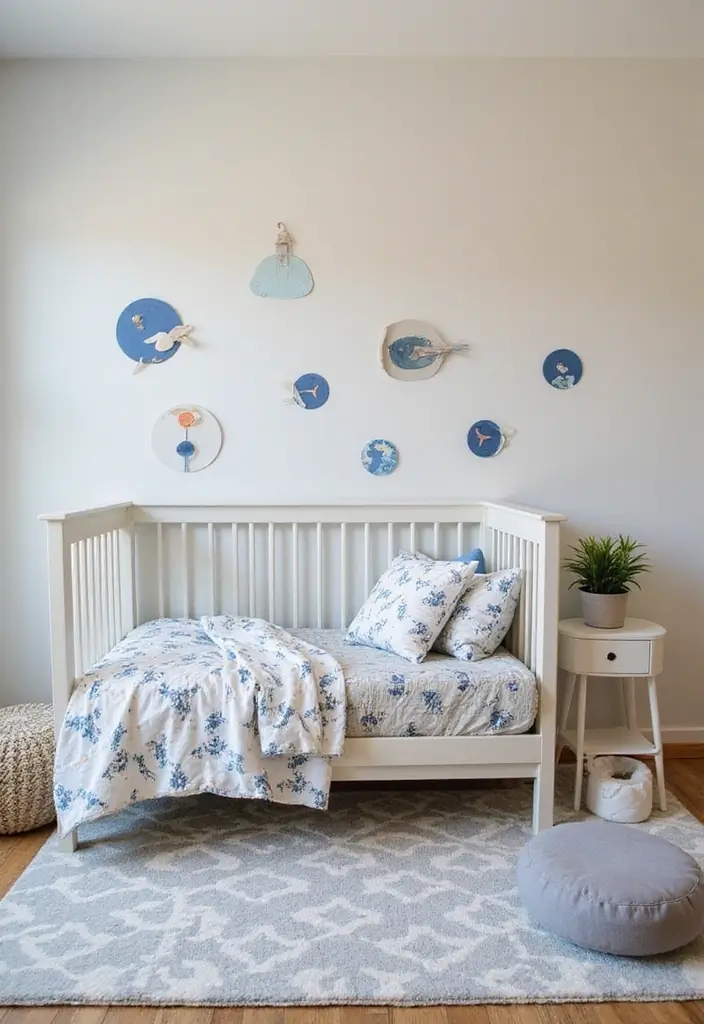
You want a baby boy room that stays fresh as he grows. Customizable decor helps you do that without buying new furniture every year. It keeps the space personal and easy to update. Here is how to use these ideas in a practical way.
– Removable wall decals: Pick wall decals that peel away cleanly. They slot into any color scheme and are easy to switch when your child’s interests change. Choose space cars, animals, or sports themes for quick updates.
– Bulletin board or magnetic wall: Install a cork board or magnetic paint panel. It gives you a place for photos, art, and notes. Rotate items every week to keep the room lively.
– Reversible bedding: Look for bedding with two designs in one. You get two looks without buying a new set. It helps you change the vibe for seasons or moods.
– Modular furniture: Choose pieces that can reconfigure. A crib that converts to a bed, a dresser that doubles as a changing station, or shelves that move around. This keeps the room useful as your child grows.
– Interchangeable decor elements: Keep a stash of fixtures you can swap. Swap lamps, curtains, and cushions to refresh color without a full redo. Pair with fabric swatches to plan a new palette.
Start small. You will see big changes over time.
21. Nature-Inspired Wall Murals
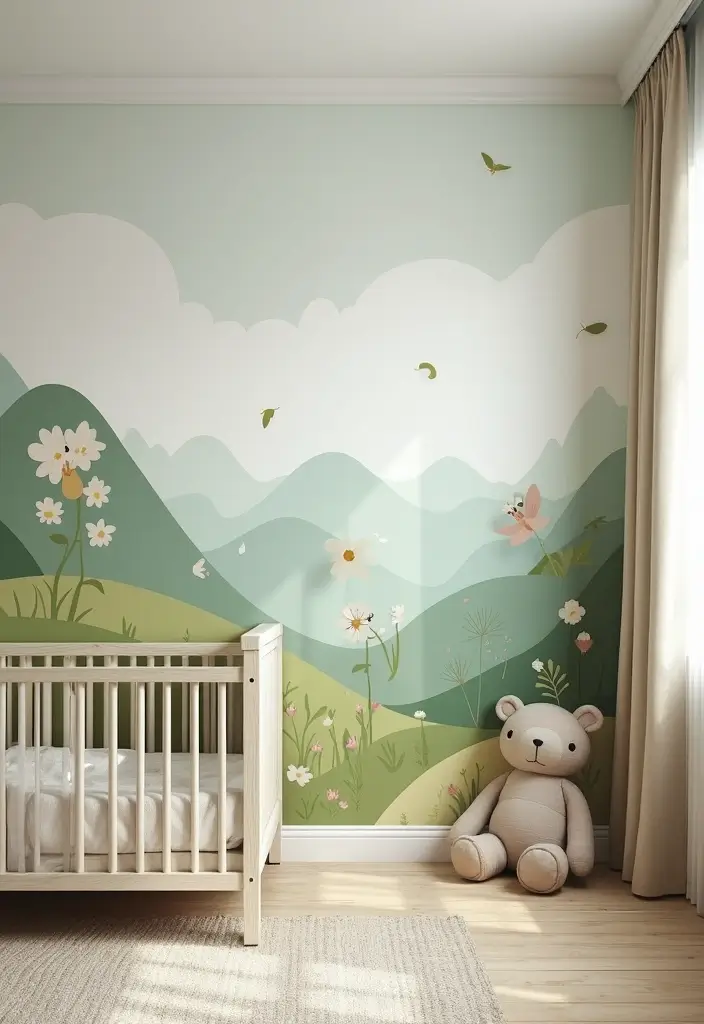
You want a baby boy’s room that feels calm and cozy. A nature-inspired wall mural can be the room’s quiet star. It gives a soft backdrop for sleep and play and sparks imagination in a gentle way.
Here is why it helps. A mural ties colors, furniture, and toys into one calm scene. It can make the room feel bigger and more inviting.
Tips to get it right:
– Pick murals that match the room’s color palette for a tidy look.
– Choose removable options, like peel-and-stick decals, so you can swap as your child grows.
– Use the mural to carve out zones, such as a reading nook or a soft-floor play area.
– Favor tranquil scenes: gentle forests, small animals, or a calm river.
What to choose and how to apply. You can go with large wall decals, a full-wall mural, or a framed canvas scene. Peel-and-stick murals are easy for beginners and won’t ruin walls.
Next steps. Start with a small test area to see how the colors look in daylight. Then plan the rest around that focal point.
Nature-inspired murals boost the room’s style and keep the space peaceful for sleep and play.
This small step can make a difference.
22. Creative Ceiling Designs
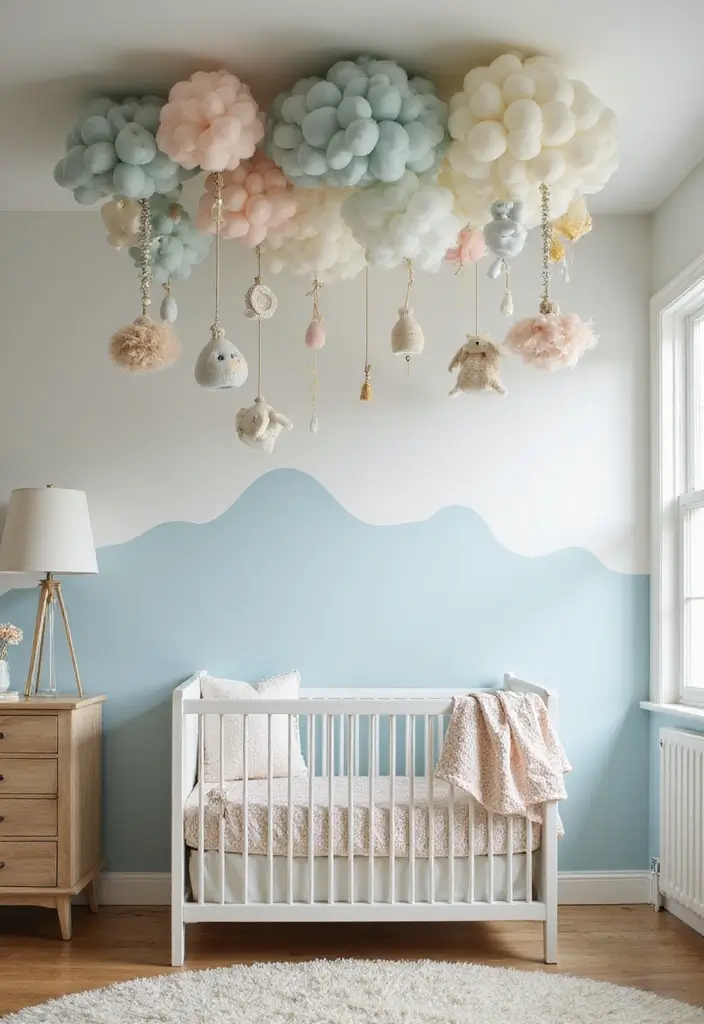
If you want a ceiling that adds calm and charm to a baby boy’s room, you’re in the right place. A well chosen ceiling acts like a soft sky above the crib. It can make the room feel bigger and set a soothing mood for naps. These ideas are practical and safe.
Here is why ceiling ideas work. They guide the eye upward, add texture, and create a gentle, sleepy ambiance.
– Painted ceilings – Choose a soft color like pale blue, white, or mint. Keep the pattern simple to match the theme.
– Starry night ceiling – Apply glow stars or a constellation. They glow softly after lights out.
– Mobile accents – Hang lightweight mobiles from a ceiling hook. Place them where they sway but stay away from the crib.
– Wood beams for texture – Add thin faux beams along the ceiling edge. They bring warmth without crowding the space.
– Clouds and sky mural – Use a sponge to dab soft clouds. It feels airy and calm.
– Ceiling decals – Stick removable decals like stars or balloons. Swap later for a fresh look.
– Soft edge lighting – Install a dimmable LED strip along the edge. It glows warmly at bedtime.
– Fabric canopy touch – Drape light fabric near the ceiling to soften light.
– Ceiling medallion finish – Place a small ceiling medallion around the light. It creates a simple focal point.
Take your time and test a patch first. This helps you see how the space feels before you commit.
Next steps: choose one idea, buy safe materials, test color on a hidden spot, mount hardware securely, and keep items lightweight. If in doubt, hire a pro.
A beautifully designed ceiling can turn your baby boy’s room into a serene sanctuary, guiding the eye upward and creating a peaceful space for sweet dreams. Elevate your nursery with calm colors and gentle patterns!
23. Layered Lighting Techniques
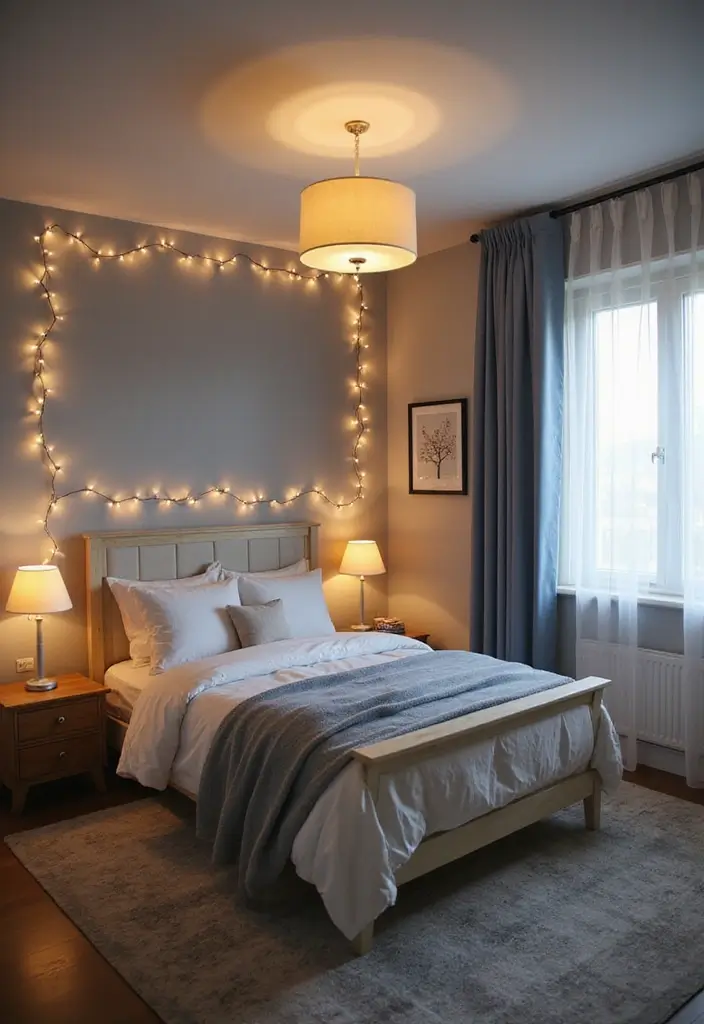
You want a baby boy room that feels calm and easy to use. Layered lighting gives you that. It blends soft ambient light with practical task light and small accents you can switch on as needed. Here is how to build it.
– Central ceiling fixture for general illumination. Pick a warm bulb that fills the room without glare.
– Bedside lamps for reading or nighttime checks. Choose a compact design with a simple switch and gentle light.
– Decorative string lights for a cozy glow. Drape them along a shelf, headboard, or window frame.
– Accent lights to highlight art or favorite decor. A tiny LED spot or wand light works well near a wall display.
Next, add controls and mood makers. A dimmer lets you soften the light for naps or late-night feeds. Several fixtures give you options without washing out the space. Colored bulbs can add a playful touch, but keep colors muted and kid-friendly.
Tips to get the most from layered lighting. Use LED bulbs for long life and low heat. Choose warm white for a calm feel. Place lights where they won’t shine directly into little eyes or onto screens. Keep cords tucked away to reduce clutter.
As your child grows, adjust the plan. A sturdy lamp remains useful, while decor accents can shift with their interests. Layered lighting stays helpful for play, story time, and quiet moments.
Next steps.
Layered lighting is the secret ingredient for a calm and cozy baby boys bedroom. Mix soft ambient light with task lighting to create a space that’s both practical and inviting!
24. Playful Canopy Bed
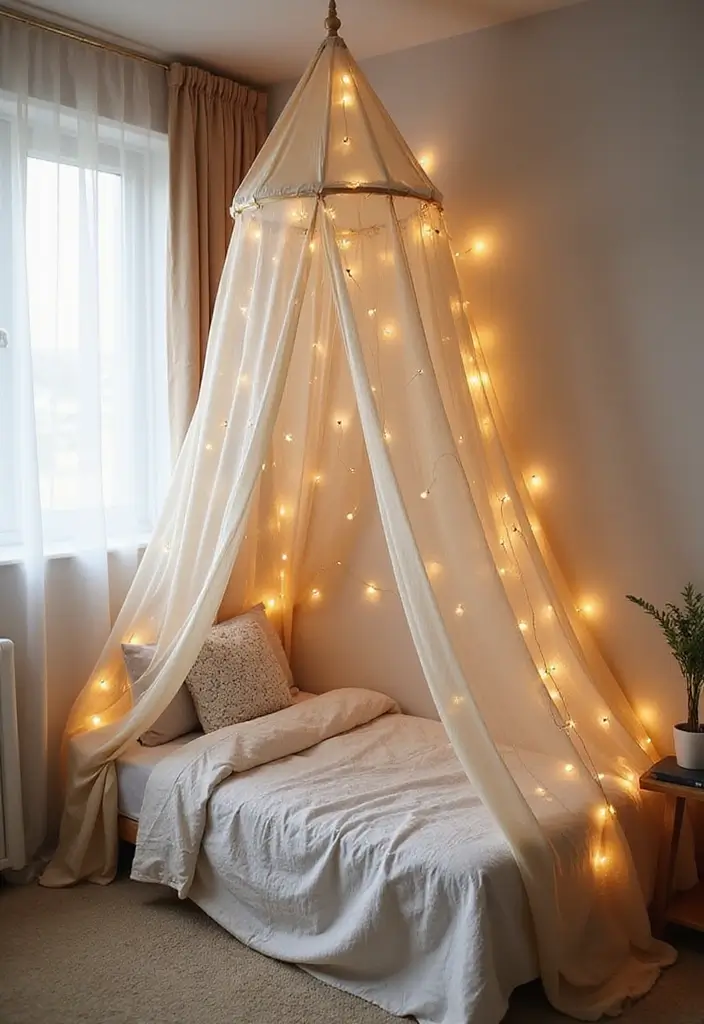
Playful Canopy Bed
Want a baby boy room that feels magical yet calm? A playful canopy bed can do that without making the space busy. It adds coziness and a hint of adventure, turning the bed into a small retreat. Use lightweight fabrics you can swap as your child grows.
– Use a simple frame and drape sheer fabric or lightweight curtains for an airy look.
– Choose fabrics in soft colors that match the room’s decor.
– Add fairy lights or hanging mobiles to boost charm.
– Let the canopy define sleeping space in an open or shared room.
This idea works in small rooms too by creating a cozy corner.
Here is why it works. Kids love small worlds, and a canopy makes a space feel private. The fabric softens the light and adds a sense of calm. It also keeps the bed feeling cozy in a larger room.
Next steps
– Pick a canopy height that fits your ceiling and bed.
– Use battery-powered fairy lights for safe, gentle glow.
– Tie the fabric loosely to keep it easy to wash and swap.
– Check for sharp edges and keep kids’ play clear of the frame.
With these steps, you gain a playful yet calm focal point that grows with your child.
25. Integrating Technology
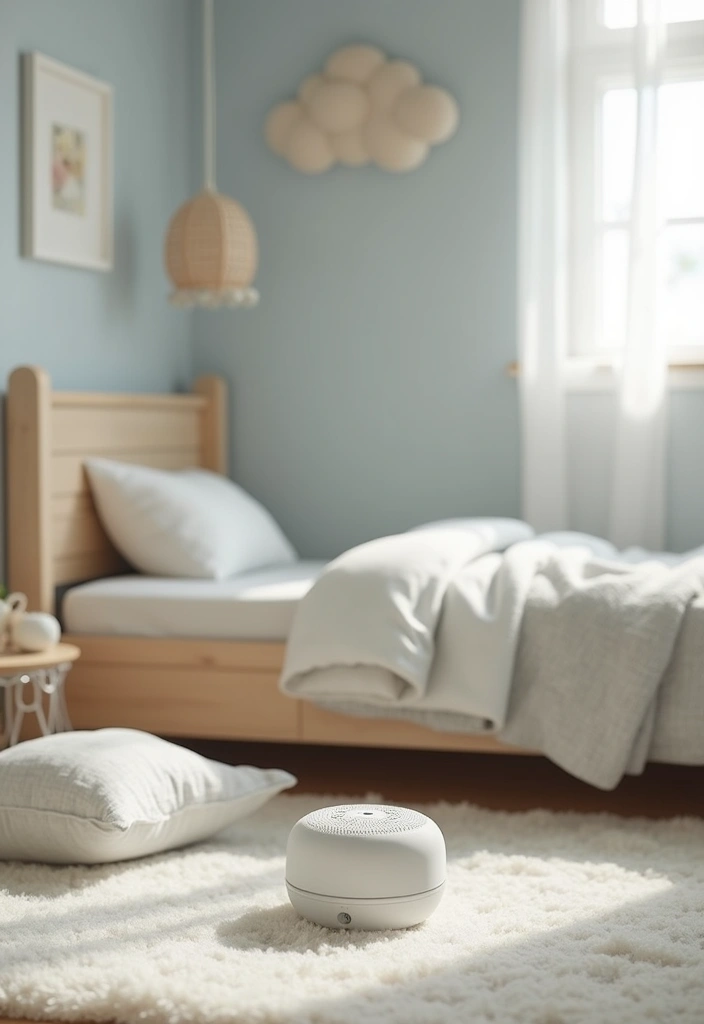
Your baby deserves a room that stays calm and safe, even when you are not in the room. Tech can help you watch, soothe, and plan without waking your child. You can add simple tools that fit your style and budget.
– Smart lighting that fits a schedule
Use lights that shift from bright daytime glow to soft warm tones at night. A timer or your phone can run the schedule. This helps your baby learn bedtime cues and saves energy.
– Soothing sounds with a compact sound machine
Place it near the crib. It makes steady white noise or soft lullabies to help sleep. Keep the volume low so it calms without waking.
– Video baby monitor on your phone
Check in without leaving bed. Look for a model with secure data and good night vision. Turn on privacy settings and only share video with trusted devices.
– Apps to track feeds and sleep
Log feeds, diaper changes, and naps. Review patterns to spot trends. Keep data private on your device.
– Room climate sensors
A sensor shows temperature and humidity. It helps you keep the room comfy. Pair it with your thermostat or fan for quick fixes.
Next steps. Start with one or two tools and test them for a week. Remember, tech should support care, not replace it. If you pick quiet devices and set limits, tech helps you feel calmer.
26. Simple Upholstered Furniture
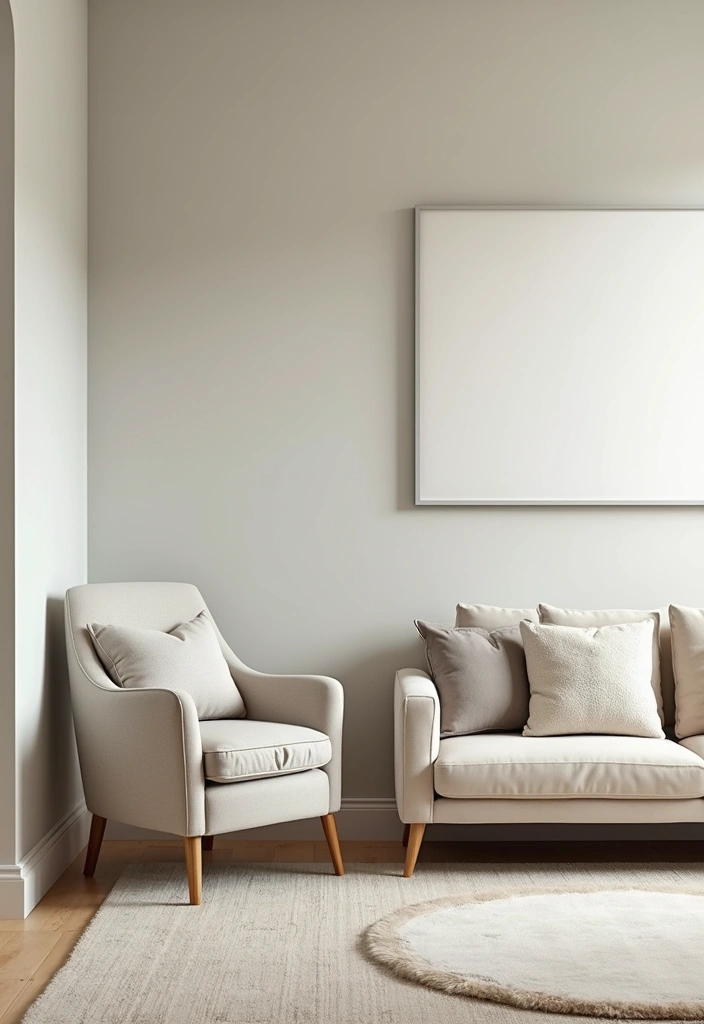
Simple Upholstered Furniture
You want a room that feels soft and calm. Upholstered pieces add warmth without making the space look crowded. Pick options that are easy to clean, built to last, and safe for little hands.
Materials to look for include microfiber and performance fabrics. They resist stains and wipe clean with a quick wipe. Some seats come with slipcovers you can wash in the washing machine. A comfortable chair with good back support makes long stories easy.
– Choose a small upholstered chair for reading and cuddling.
– Add a compact sofa if space allows.
– It provides extra seating for family stories.
– Look for durable fabrics with tight weaves.
– Pick colors that fit your palette.
– Check for removable covers or washable slipcovers.
– Think about placement near a low shelf and a soft rug.
– Know fabric care labels before you buy.
Care tips
– Vacuum weekly and spot clean spills with a damp cloth.
– If covers are washable, follow care labels and air dry.
– Use a washable throw or blanket to protect cushions.
Limitations
– Upholstered pieces can show wear over time. Darker tones and plain patterns hide marks better.
Next steps
– Measure your space, compare fabrics, and test for comfort before you buy.
– Make sure you love the look and feel.
27. Creative Play Mats
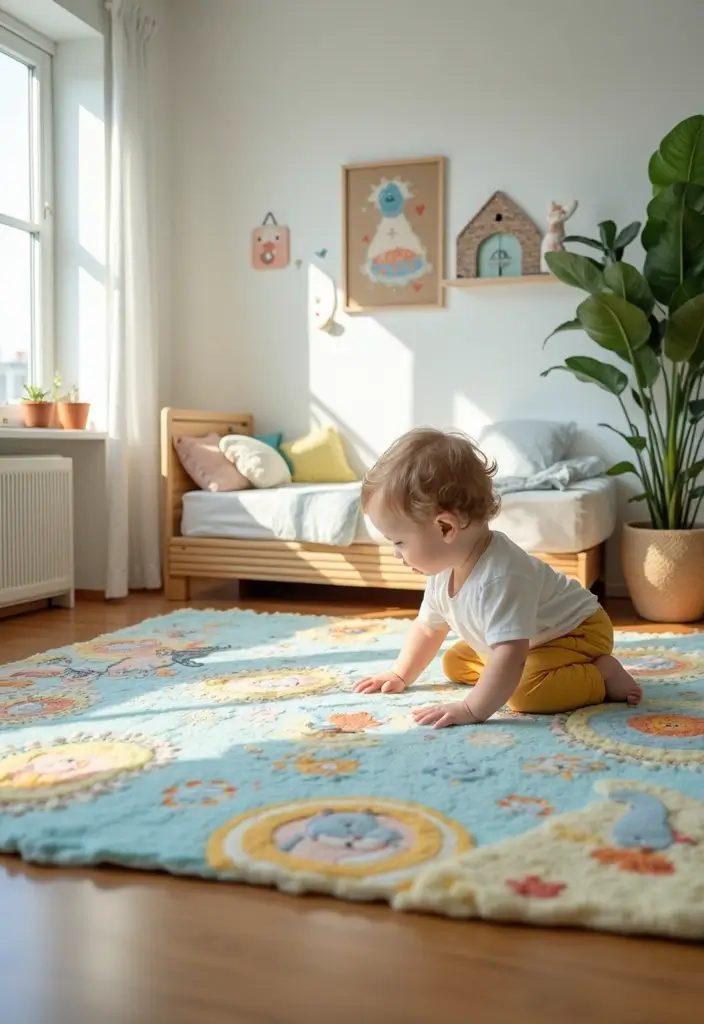
Your baby deserves a play space that is cute, calm, and easy to care for. Creative play mats do that while adding color and texture to the room.
– Color and touch Choose a mat that is colorful and soft to touch. A gentle surface helps tiny hands grip and crawl safely.
– Theme and style Pick a theme that fits the room decor. It creates a cohesive look and sparks imagination.
– Sensory textures Look for mats with different textures for sensory play. Different surfaces invite tummy time and exploration.
– Size matters Go for a larger mat so there is room for toys and a friend. Bigger space reduces crowding and keeps play calm.
– Easy care Choose washable options to keep the area clean. Removable covers make quick cleaning a breeze.
– Safety first Add a non-slip backing for safety. This helps mats stay in place on slick floors.
– Modular setup Consider interlocking mats to customize the layout. You can change shapes as your child grows.
– Educational themes Use mats with simple shapes, colors, or animal graphics. These help little minds notice details during play.
– Play zone placement Let the mat define the play area. Place it on a soft rug for extra coziness.
– Storage and mobility Keep mats easy to store and move. Look for foldable, rollable, or low-profile designs.
– Space around Leave space around the mat for safe transitions. A tidy zone feels calmer.
– Family play A larger mat invites siblings or friends to join. Shared play builds social skills.
With these mats, your baby will have a cozy space that invites play and curiosity.
28. Stylish Crib Alternatives
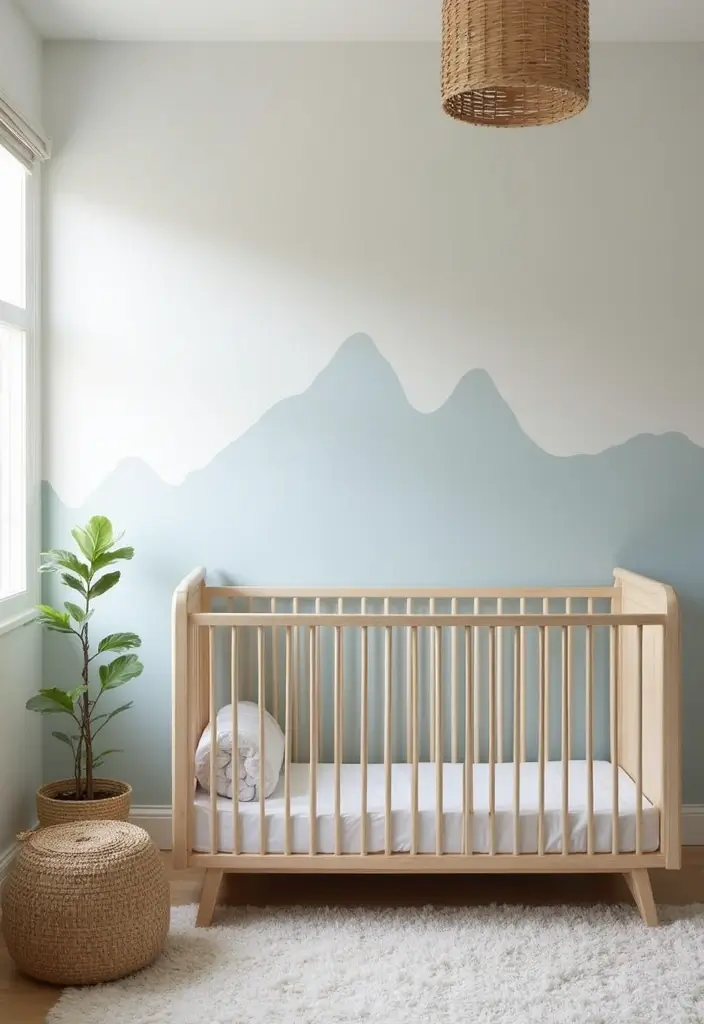
If you want a sleep space that looks nice and stays safe, consider crib alternatives. You get style and ease with the right choice.
– Convertible cribs help them grow with you. They switch from a crib to a toddler bed or daybed, so you don’t have to buy more later.
– Moses baskets add charm and mobility. They are lightweight and decorative. Place one beside your bed for late night feeds, then tuck it away if you need the space.
– Cribs with thoughtful details bring character. Look for curved edges, soft hues, or a warm wood finish. These touches make the room feel special without shouting.
– Gentle rocking cradles soothe baby. A smooth motion can help them settle. Choose a cradle with sturdy supports and quiet movement.
Here is why these options fit a calm, cozy room: they blend with furniture, use safe materials, and adapt as your family grows. When you shop, pick non-toxic finishes, proper slat gaps, and solid construction. Pair with natural textiles like cotton sheets, a wool rug, and a linen blanket to pull the look together.
Next steps: measure your space, compare colors to your wall tones, and test how easy it is to move or adjust each piece. With the right pick, your nursery stays stylish and safe.
29. Art and Craft Corner
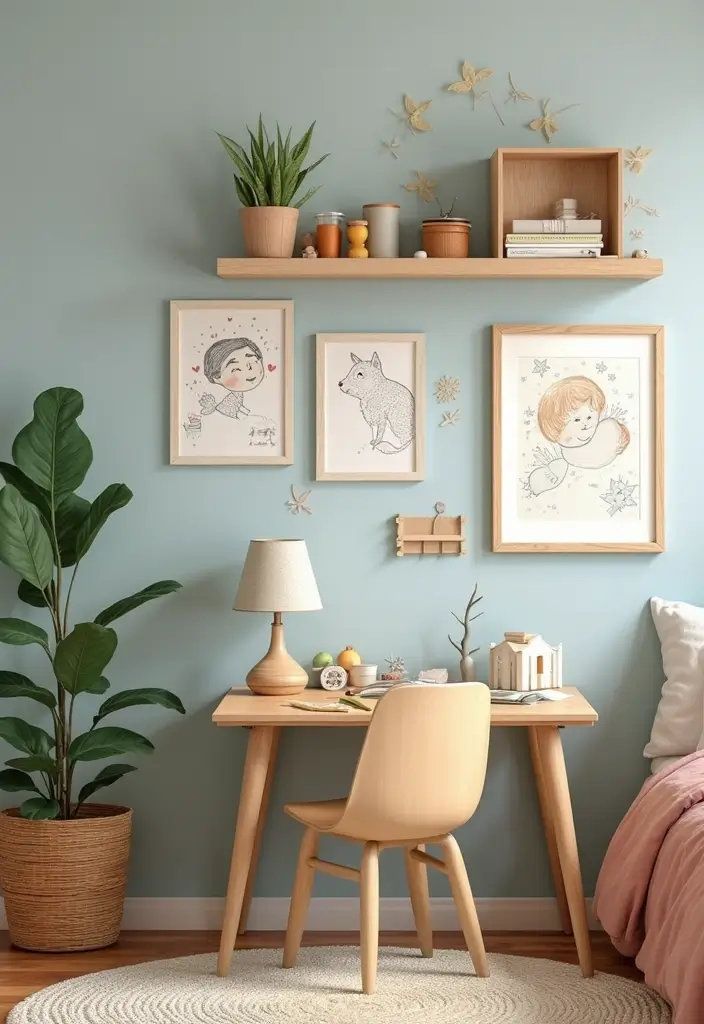
Is your child drawn to art but you hate the mess spreading through the house? A dedicated art and craft corner can change that. It gives your kid a safe, focused spot to try colors, cut paper, and glue, with the rest of the room staying tidy. This home art station makes creativity part of daily life without chaos.
What to include
– A small table and kid‑size chairs for comfort
– Crayons, markers, colored pencils, and plain paper
– Safe scissors, glue sticks, tape, and a glue bottle if needed
– Scrap fabric, stickers, stamps, and simple paints
– A cup of water, a cloth, and plenty of wipes
– Clear, labeled containers so each item has a home
Design tips
– Keep supplies within easy reach but stored in labeled boxes
– Add a cork board or magnetic wall to showcase finished art
– Display a few favorites to spark new ideas
– Use a washable rug or mat to catch spills and keep cleaning simple
Next steps
– Set a short daily art routine, even 15 minutes
– Rotate supplies weekly to keep things fresh
– Let your child pick projects and lead the way
This craft corner invites steady, joyful creativity and helps you keep mess contained in one neat zone.
30. Musical Elements
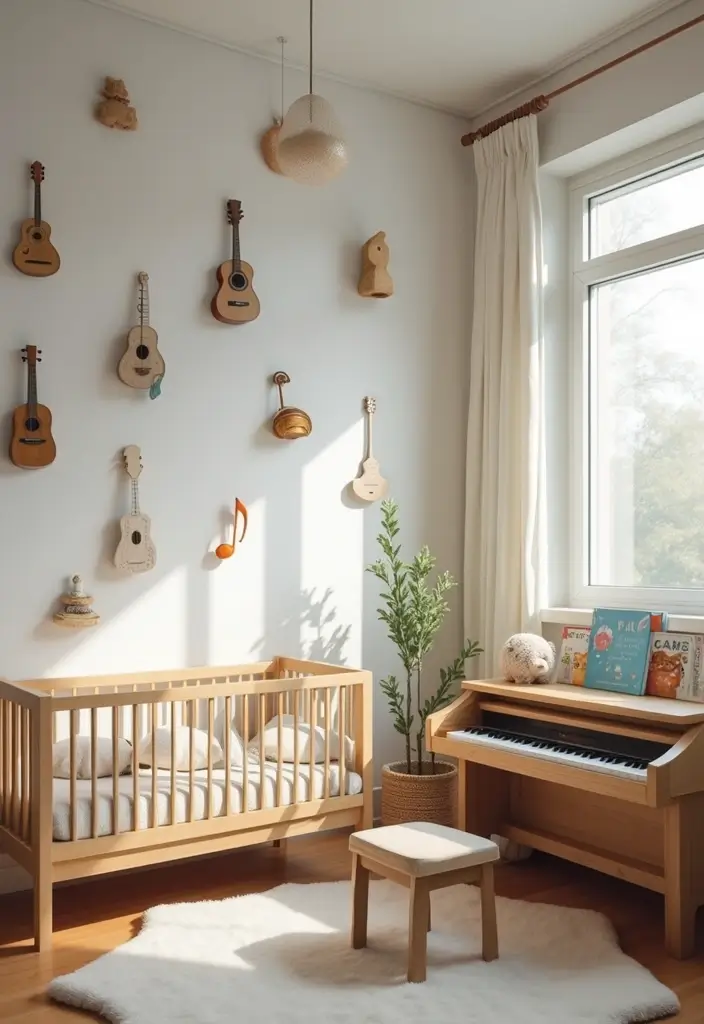
You want a baby boy room that feels calm, cute, and cozy. A musical touch can help. Here is how to add sounds that soothe, teach, and entertain without clutter.
– Musical corner Start with a low shelf. Put a safe toddler keyboard, a wooden xylophone, and a soft drum there. Let him reach and explore with curious hands.
– Wall art Pick wall decals that show notes or small instruments. Bright colors grab attention and prompt listening as you walk by.
– Musical books Add a tiny book rack filled with musical picture books. Read aloud in rhythm to boost language and listening skills.
– Melody toys Choose toys that play gentle melodies or soft sounds. Check for a volume control so you can keep it calm.
– Listening nook Create a cozy spot with a comfy seat and a kid-safe speaker. Dim the lights for a relaxing listening moment before bed.
– Sound-friendly decor Layer textures with a soft rug, warm curtains, and natural wood furniture. These soften echoes and add warmth.
– Safety and order Tuck cords away. Inspect toys for safe age use and keep small parts out of reach.
– Budget tips Reuse what you have, swap one item each season, or DIY up a shaker from a sealed jar for extra charm.
– Maintenance Rotate a couple of pieces every few weeks to keep the space fresh and inviting.
Next steps: choose two ideas to start this week, then watch how your little one responds and adjust as needed.
A musical touch can transform your baby boy’s bedroom into a serene haven. Discover how soothing sounds can inspire curiosity and creativity, making the space both calm and cozy!
Conclusion
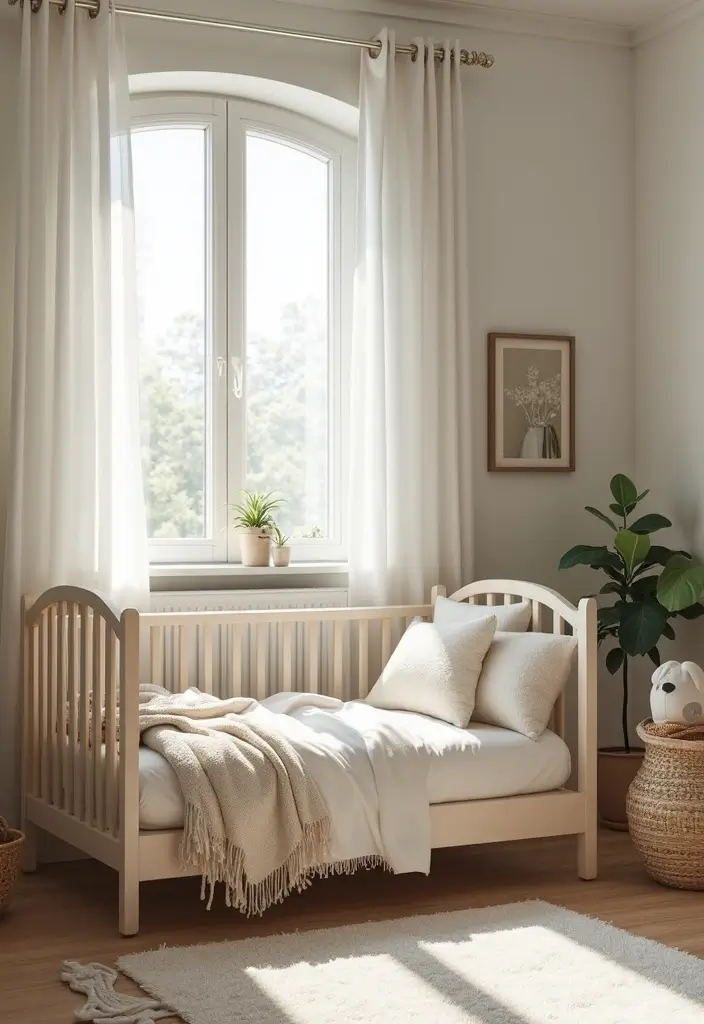
Designing your baby boy’s room can be a delightful experience filled with creativity and love.
By incorporating elements that are cute, calm, and cozy, you can create a nurturing environment where your little one can thrive. Each of these 30 ideas offers a unique perspective on how to blend functionality with style, ensuring a beautiful space for your child.
As you embark on this journey, remember that the best designs are those that reflect your family’s personality and values.
Frequently Asked Questions
What are some key elements to consider when designing a baby boy’s bedroom?
When designing a baby boy’s bedroom, focus on creating a space that feels both calm and cozy. Consider using a soft Scandinavian color palette with muted blues and gentle grays to promote tranquility. Incorporate functional furniture that can grow with your child, and choose cozy bedding options that ensure a comfortable sleep environment. Remember, it’s all about creating a nurturing atmosphere!
How can I incorporate nature-inspired decor into my baby boy’s nursery?
Incorporating nature-inspired decor can create a warm and calming atmosphere in your baby boy’s nursery. Think about using natural materials for furniture and decor, and consider adding nature-themed wall murals or art. You can also include plants or animal motifs to bring a soothing, organic vibe into the room. These elements not only look great but also promote a peaceful environment for your little one.
What are some practical storage solutions for a baby boy’s bedroom?
To keep your baby boy’s bedroom organized and clutter-free, opt for minimalist storage solutions. Choose bins and baskets made from natural materials that blend seamlessly with your decor. Look for furniture that doubles as storage, like ottomans or benches. This way, you can maintain a serene space that is easy to tidy, allowing for more calm and cozy moments with your little one.
How can I create a cozy reading nook in my baby boy’s room?
Creating a cozy reading nook in your baby boy’s room is a wonderful way to foster a love for books. Choose a comfortable chair or a soft floor cushion and surround it with soft lighting to make the area inviting. Keep a selection of colorful, engaging books easily accessible to encourage reading time. This nook will not only serve as a great spot for bonding but also promote relaxation and creativity.
What are some tips for choosing calming color palettes for a baby boy’s bedroom?
When selecting a calming color palette for a baby boy’s bedroom, stick to soft, muted tones like pale blues, gentle greens, and warm grays. These colors create a soothing environment that promotes peace and relaxation. You can also use accent colors sparingly to add interest without overwhelming the space. Remember, the goal is to cultivate a cozy sanctuary where your baby can feel safe and calm.
Related Topics
baby boys bedroom ideas
scandinavian style
nursery design
calming color palettes
cozy bedding
minimalist storage
nature-inspired decor
themed decor
soft lighting
eco-friendly decor
interactive play areas
customizable decor

